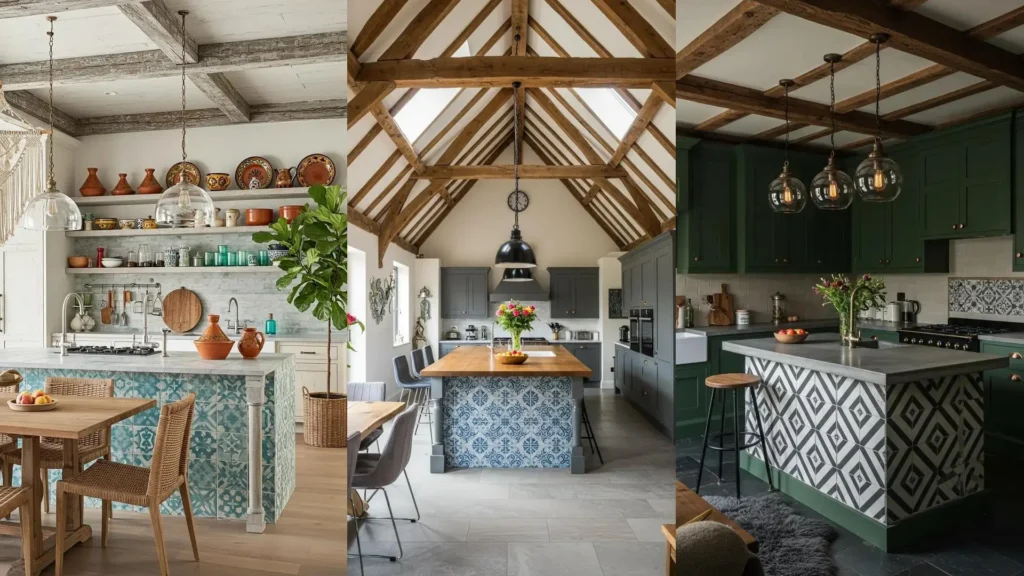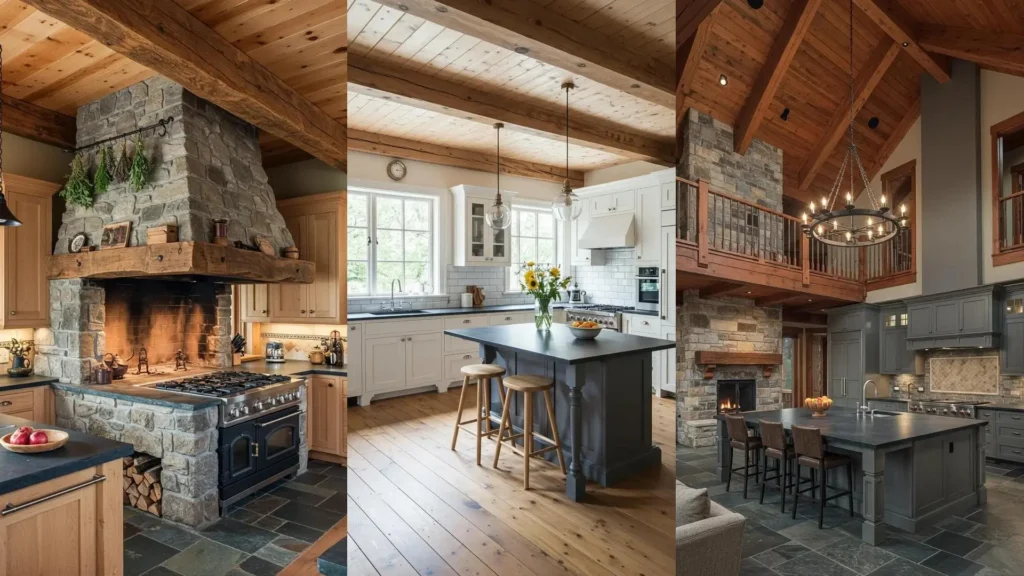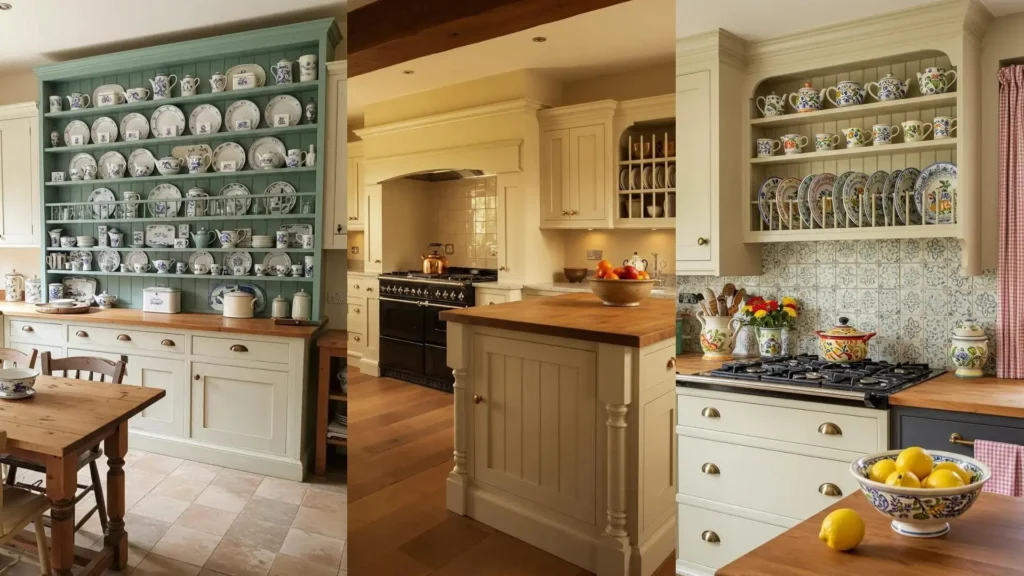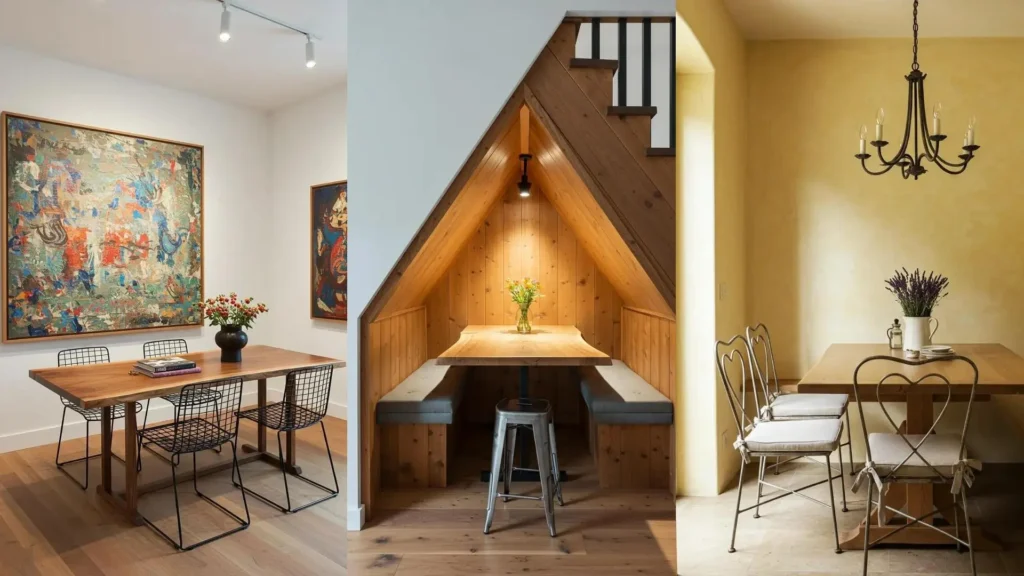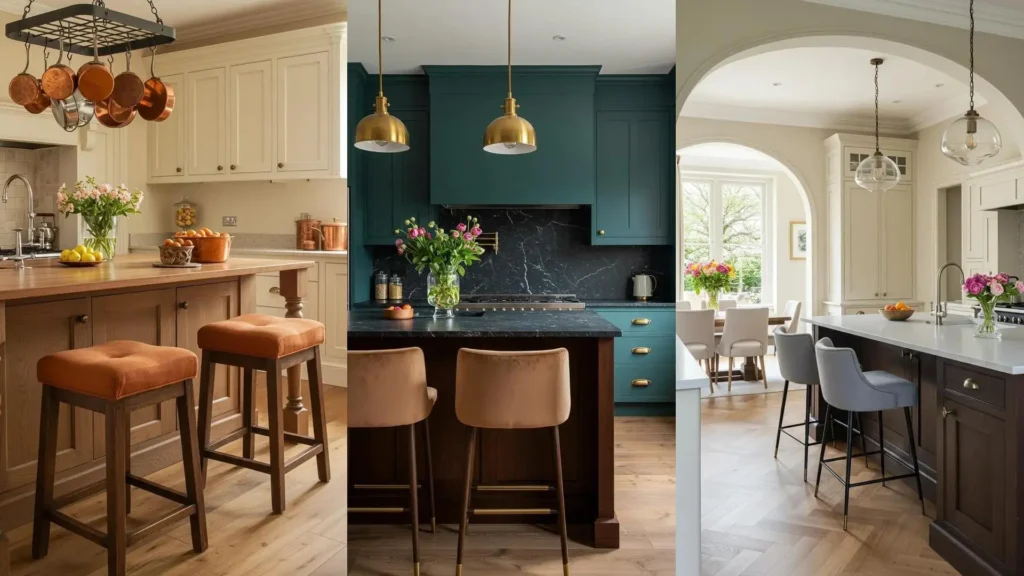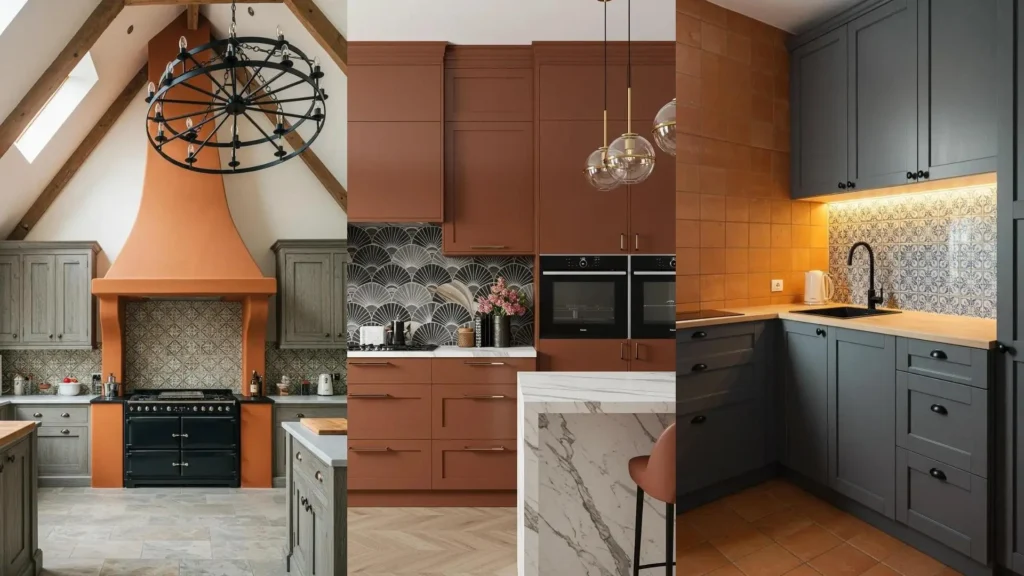Your kitchen should be more than just a functional space—it should be the heart of your home, a place that reflects your personality and warmth.
But achieving a look that feels both personal and cohesive can be a challenge. How do you add character without creating chaos?
The answer often lies in a single, powerful focal point. A kitchen island with patterned tile or an antique wooden beam can provide the perfect anchor, infusing your space with texture, color, and story.
Let these ideas inspire you to see your kitchen not just for what it is, but for what it could be.
1. The Replaceable Island Accent
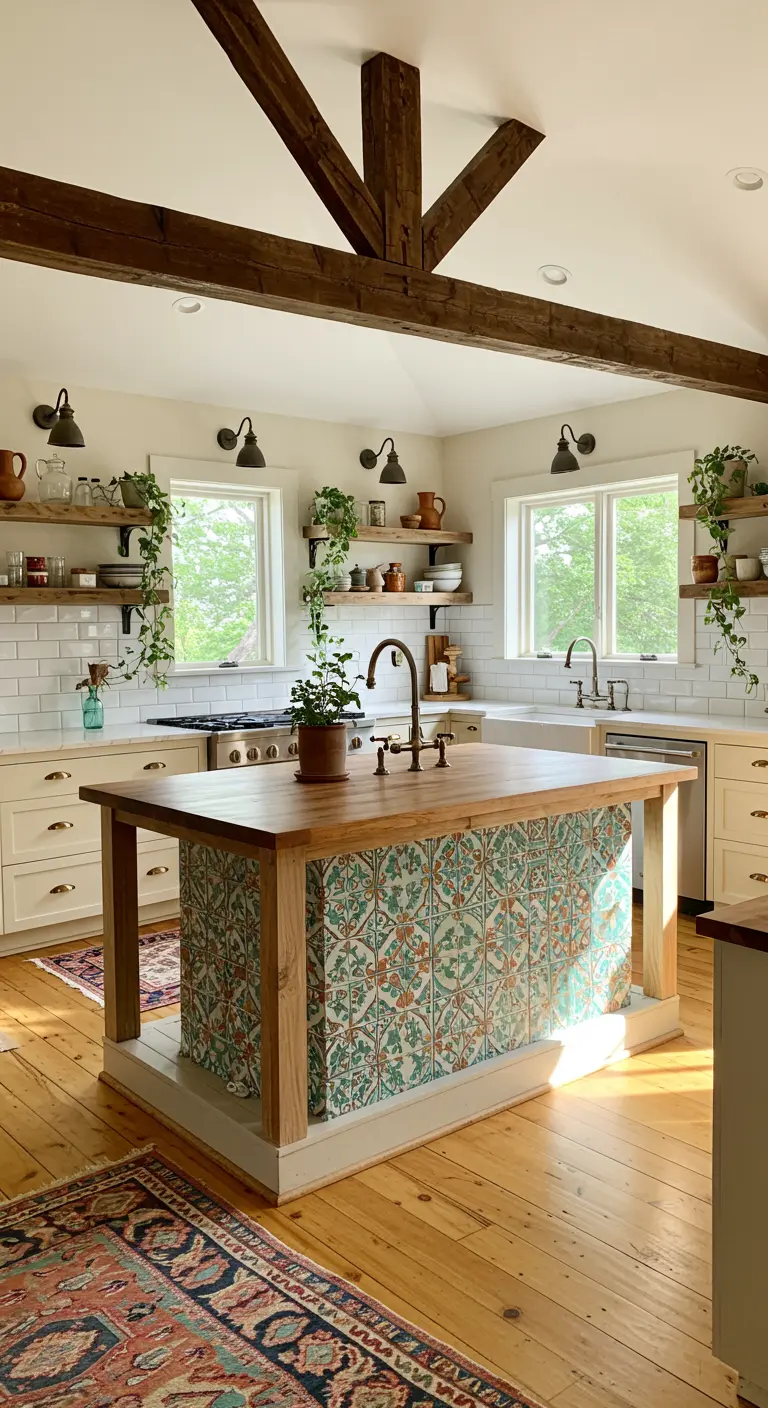
If tiling your kitchen island feels too permanent, consider this elegant alternative: applying a patterned fabric or high-quality peel-and-stick wallpaper to the base.
This method allows you to introduce color and personality with minimal commitment, making it easy to update as your tastes evolve.
To create a cohesive look, choose a pattern that echoes the colors of a nearby element, such as this beautiful Oriental area rug, which grounds the entire space.
The contrast between the rustic wooden beams and the delicate floral pattern creates a sophisticated visual balance.
2. Ground the Drama with Graphic Tile
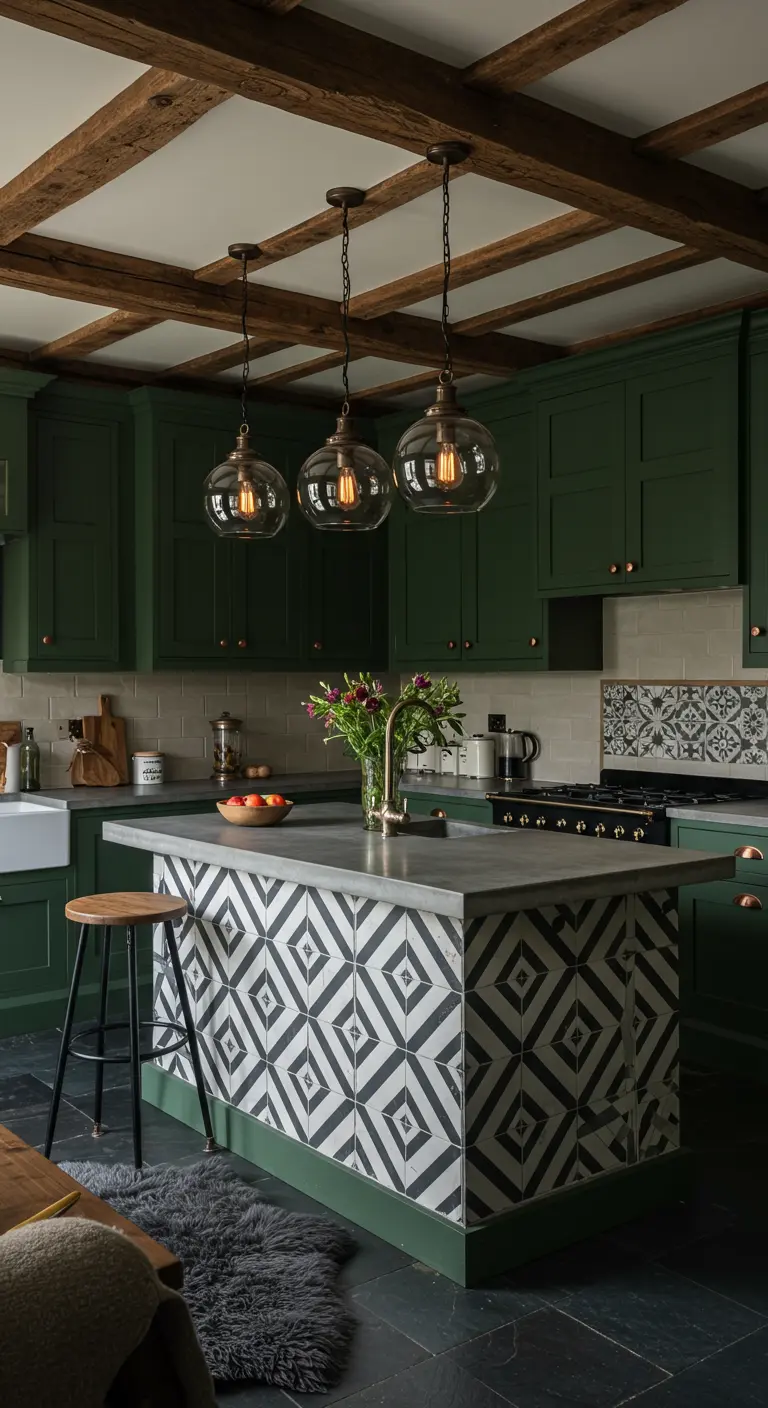
In a kitchen with deep, moody cabinetry, a bold geometric tile on the island provides a necessary visual anchor.
The high-contrast black and white pattern here prevents the dark green from feeling too heavy, injecting energy and a modern edge into the rustic framework.
Pair this look with a simple concrete or quartz countertop to let the tile remain the hero.
The glass globe pendants add a touch of industrial loft style, preventing the design from feeling overly traditional.
3. Weave in Texture for a Softer Statement
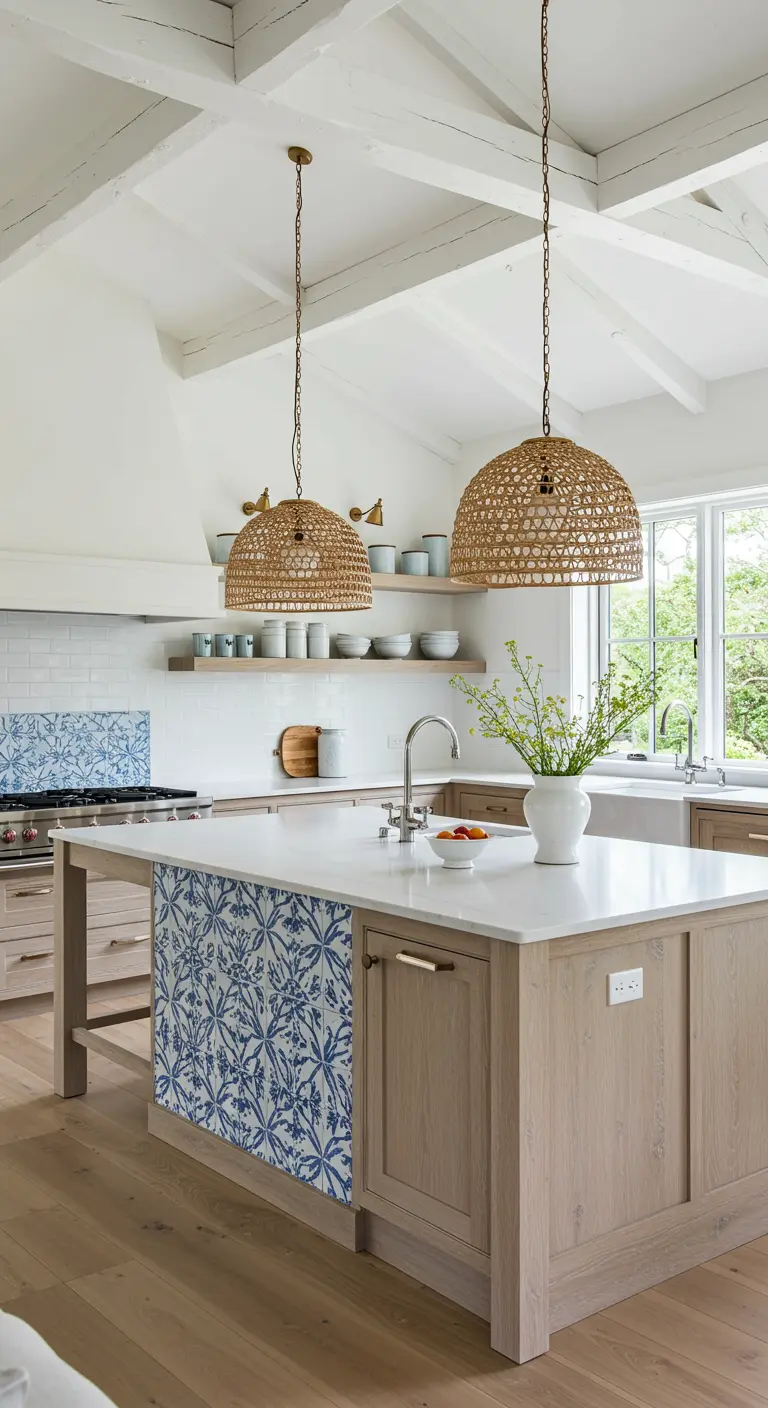
To keep a light and airy kitchen from feeling sterile, focus on layering natural textures.
Here, oversized woven rattan pendants introduce an organic, sculptural element that softens the clean lines of the white countertops and subway tile.
The blue-and-white patterned tile on the island adds a classic, almost coastal-inspired detail without overwhelming the serene palette.
The light-wash wood on the island base and open shelves ties all the natural elements together beautifully.
4. Embrace the Patchwork Effect

For a truly personal and eclectic statement, use a mix of different tile patterns on your island.
This patchwork approach transforms the island into a piece of art, telling a story of collected treasures and travels.
To make this work, keep the surrounding elements restrained—notice the simple concrete countertops, dark wood cabinetry, and exposed brick walls.
This ensures the island is the undisputed star, not a chaotic element in an already busy space.
5. Unify with a Warm, Earthy Monotone
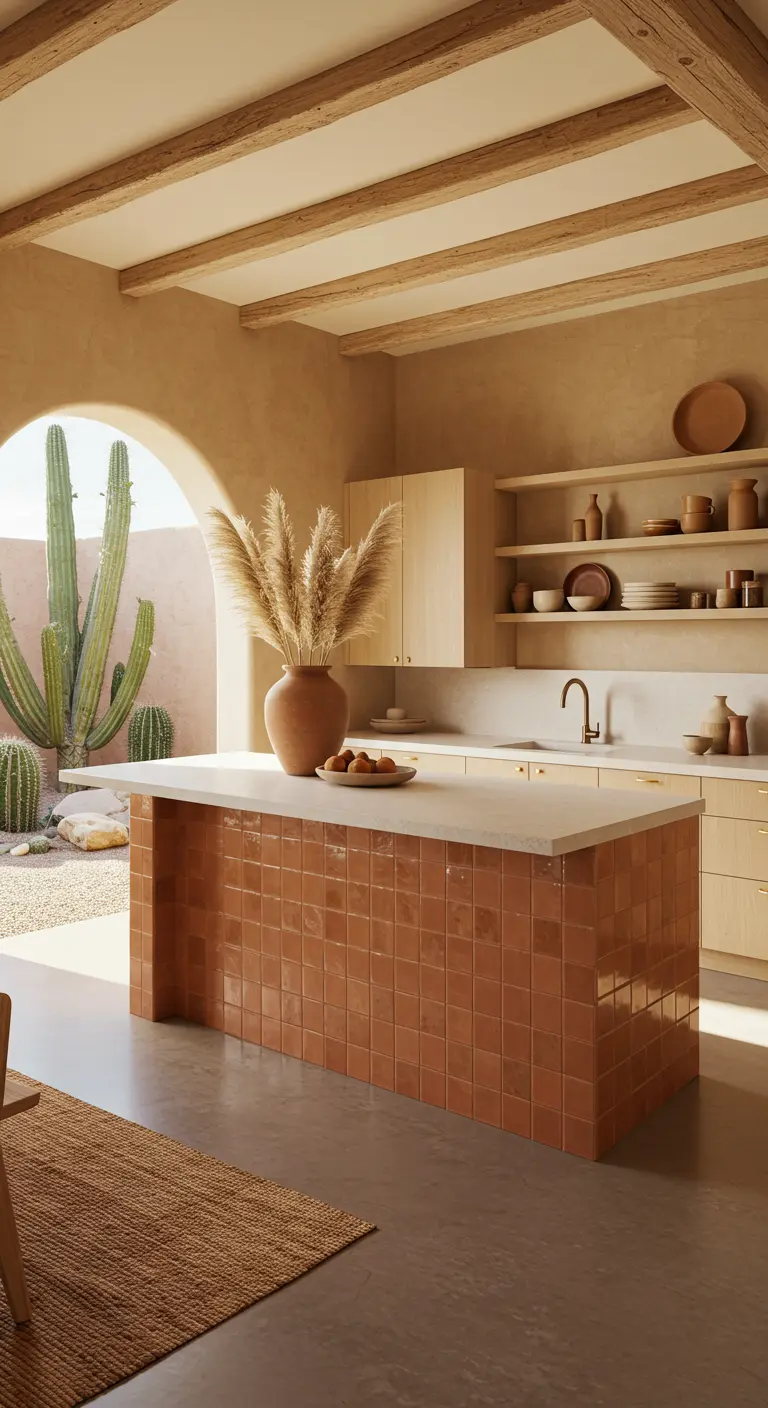
Create a seamless transition between your indoor and outdoor spaces with a palette drawn from nature.
This kitchen uses terracotta-hued zellige tiles on the island, which have a beautiful handmade quality and subtle variation in color.
The warm tone connects perfectly to the sand-colored walls and the desert garden beyond the archway, creating a serene, desert oasis feel.
Keeping the cabinetry in a light, natural wood prevents the earthy tones from feeling too heavy.
6. Complement Cabinet Color with Classic Tile

When you have distinctive cabinetry, select an island tile that complements, rather than competes with, the color.
The soft sage green cabinets are the main feature here, so the classic blue-and-white Portuguese-style tile adds a timeless, decorative touch without stealing focus.
The wooden countertop on the island warms up the cool tones of the cabinets and tile, creating a balanced and inviting atmosphere.
This pairing feels both historic and fresh, a hallmark of modern farmhouse style.
7. Layer Pattern on Pattern with Restraint
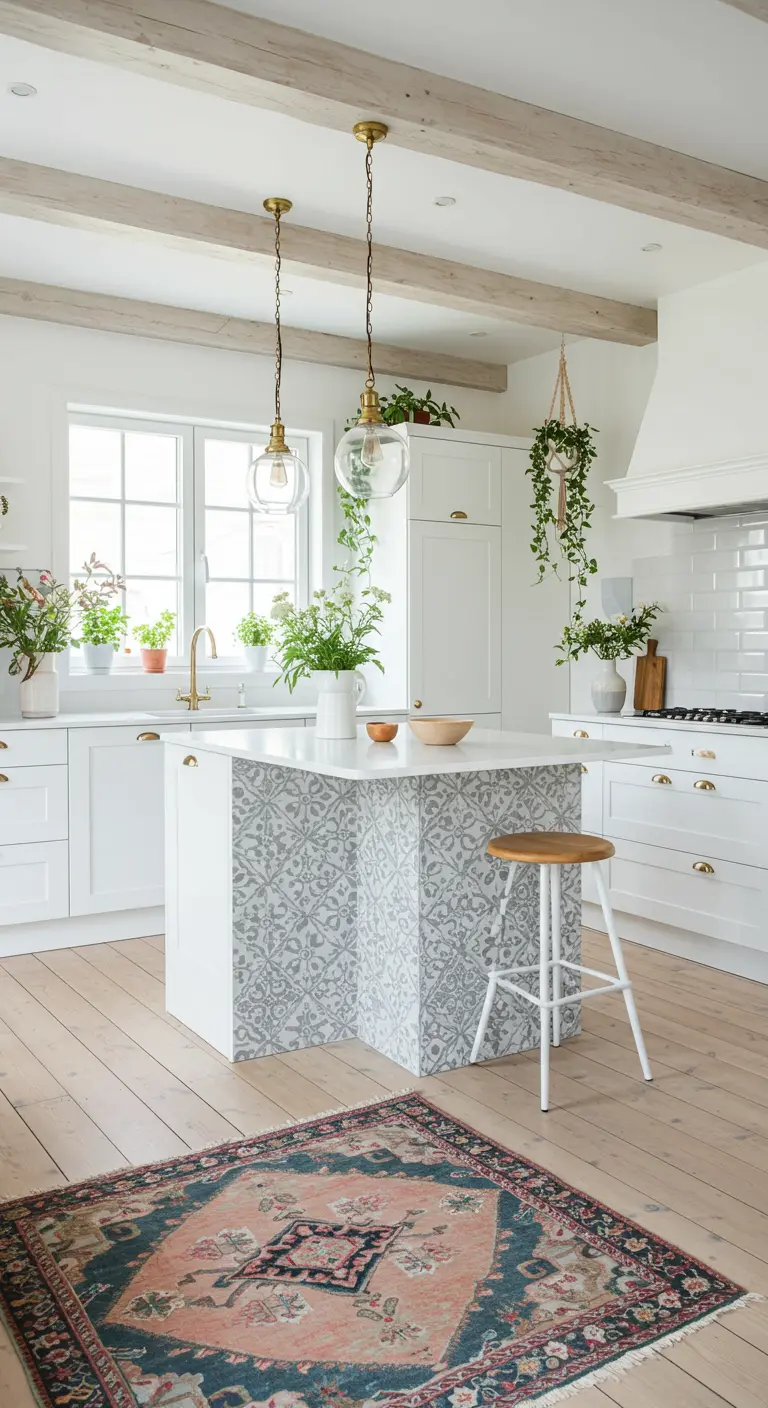
Combining a patterned island with a patterned rug can be incredibly chic if done with a clear strategy.
The key is to vary the scale and color intensity. Here, the island’s soft, low-contrast gray tile provides a textural backdrop, while the vintage-style rug introduces rich color and a more intricate design.
Keeping the cabinets, countertops, and walls bright white gives the patterns room to breathe.
Hanging plants add a touch of life, echoing the natural, bohemian feel of the rug.
8. Frame Your Island with Architectural Detail
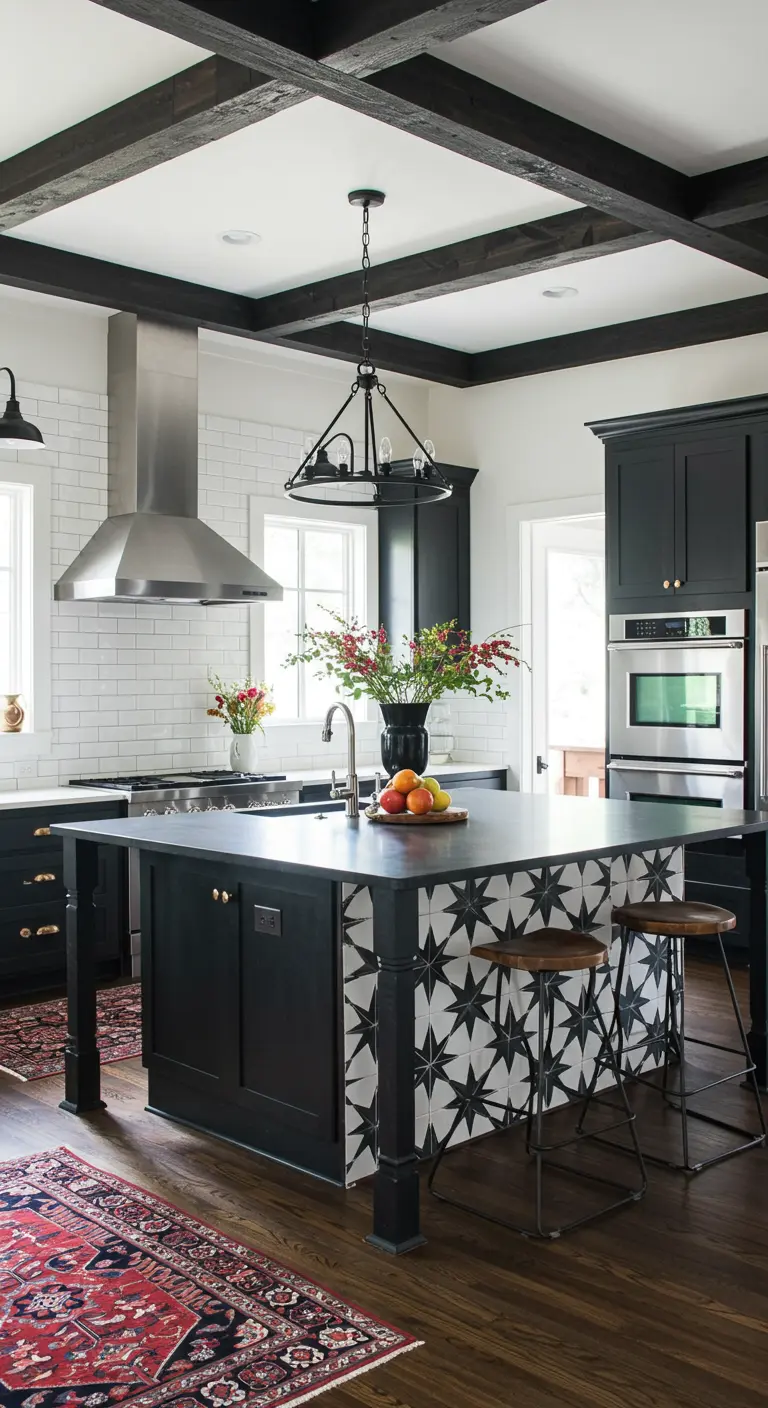
Elevate a simple tiled island by framing it with painted millwork, as seen with the turned legs and base molding here.
This technique gives the island a more substantial, furniture-like presence, grounding it in the space.
Painting the frame black to match the cabinets creates a cohesive, dramatic look, while the high-contrast star-patterned tile adds a playful, graphic punch.
The dark-stained wooden floors and matching stools add necessary warmth to the high-contrast palette.
9. Match Tile to Your Kitchen’s Undertones

For a harmonious and layered look, select an island tile with undertones that match your wood cabinetry.
The creamy, warm beige in these patterned tiles beautifully echoes the golden tones of the wood cabinets and butcher block countertop.
This creates a cohesive, sun-drenched effect that feels intentional and deeply calming, perfect for a warm rustic aesthetic.
Woven pendant lights add another layer of texture, enhancing the cozy, natural atmosphere.
10. Marry Glamour with Bold Color
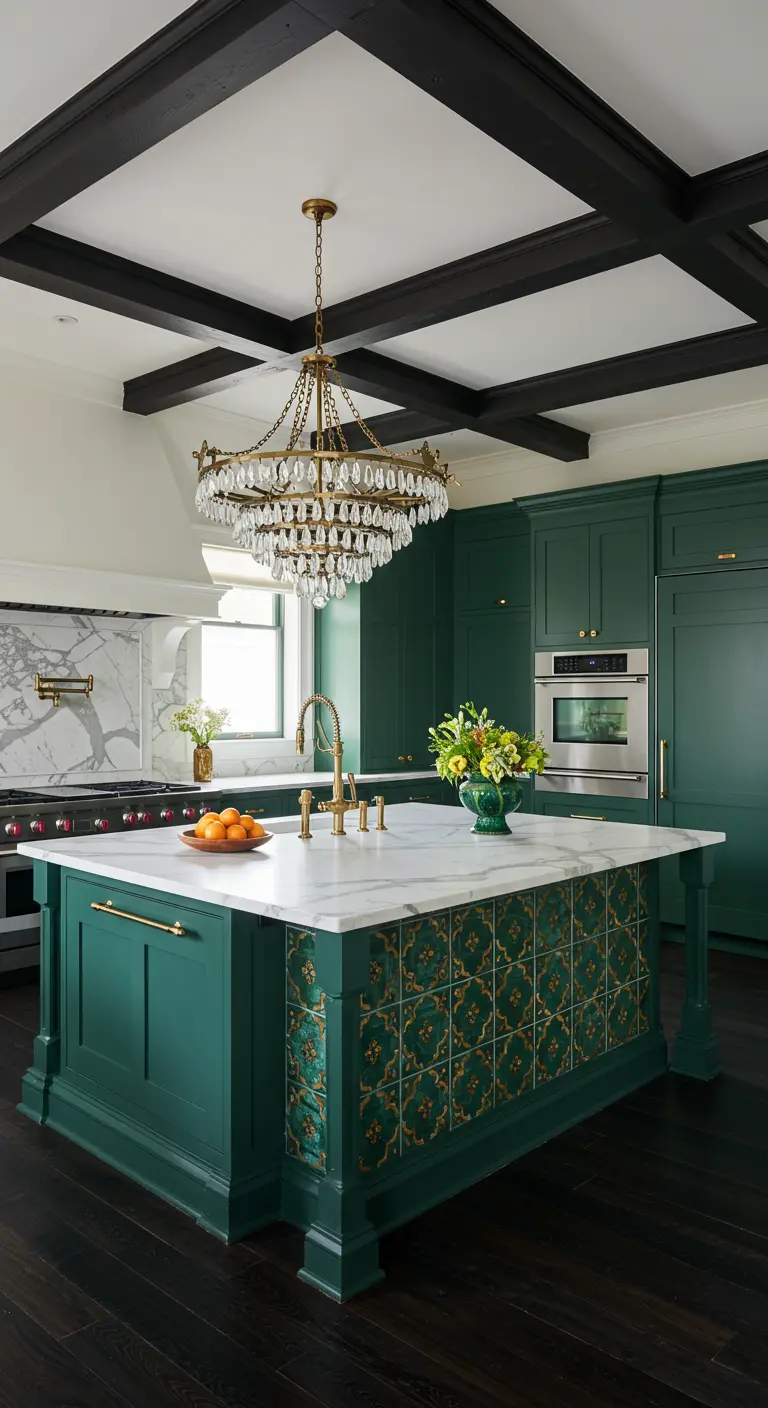
A kitchen can be both dramatic and glamorous. The key is confident execution.
Here, deep emerald green cabinets create a rich, enveloping feel, while the gold-flecked green tile on the island adds a touch of opulence.
The show-stopping crystal chandelier elevates the entire space, contrasting beautifully with the strong, dark-stained ceiling beams.
A thick marble countertop with dramatic veining provides a luxurious and practical surface that ties the look together.
11. Curate Your Shelves for a Lived-In Look
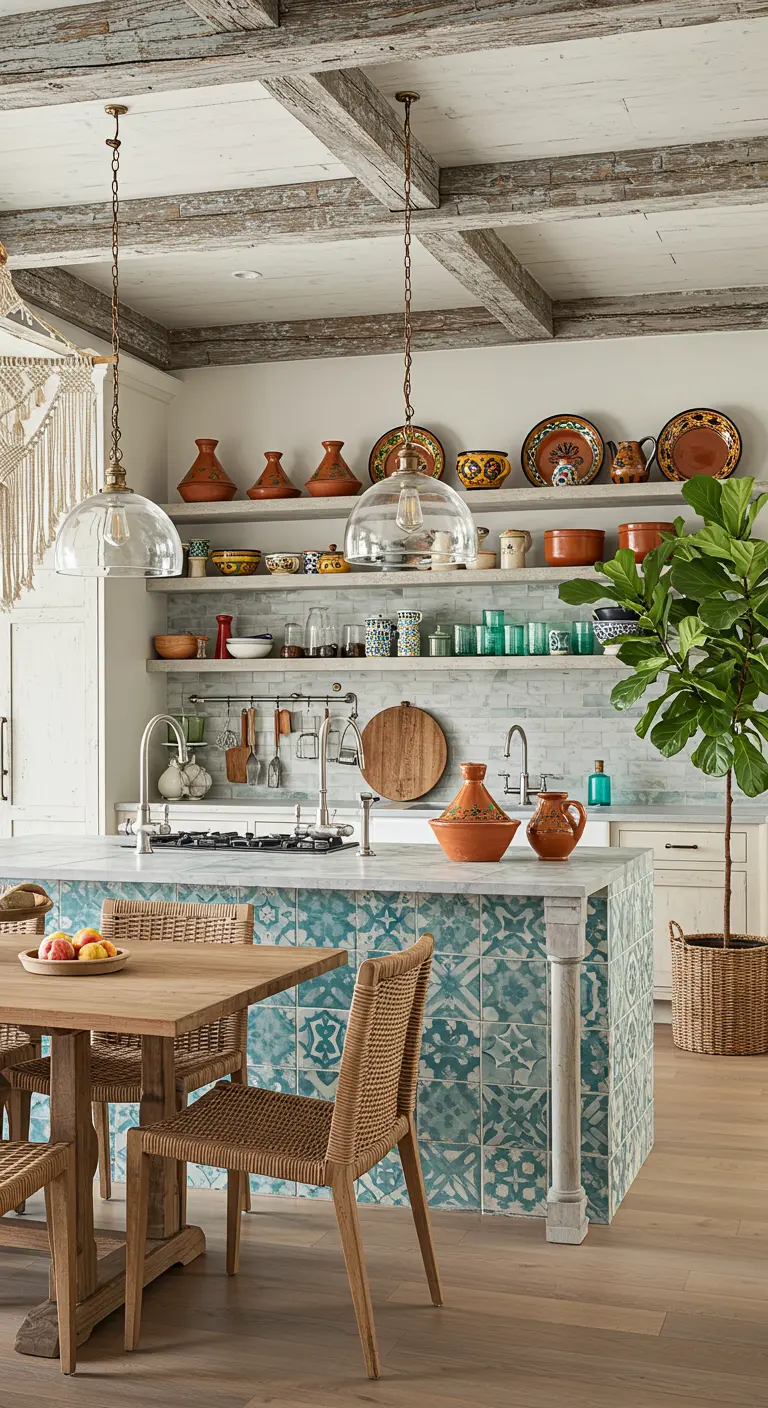
Open shelving invites you to display your personality, but it requires thoughtful curation to avoid looking cluttered.
Group items by color and material—notice the collections of terracotta pottery and green glassware, which connect to the turquoise island tile.
This approach feels personal and authentic, turning everyday objects into a design feature. It’s a hallmark of eclectic interiors.
The whitewashed ceiling beams keep the space feeling bright despite the abundance of items on display.
12. Go Rugged with Natural Stone
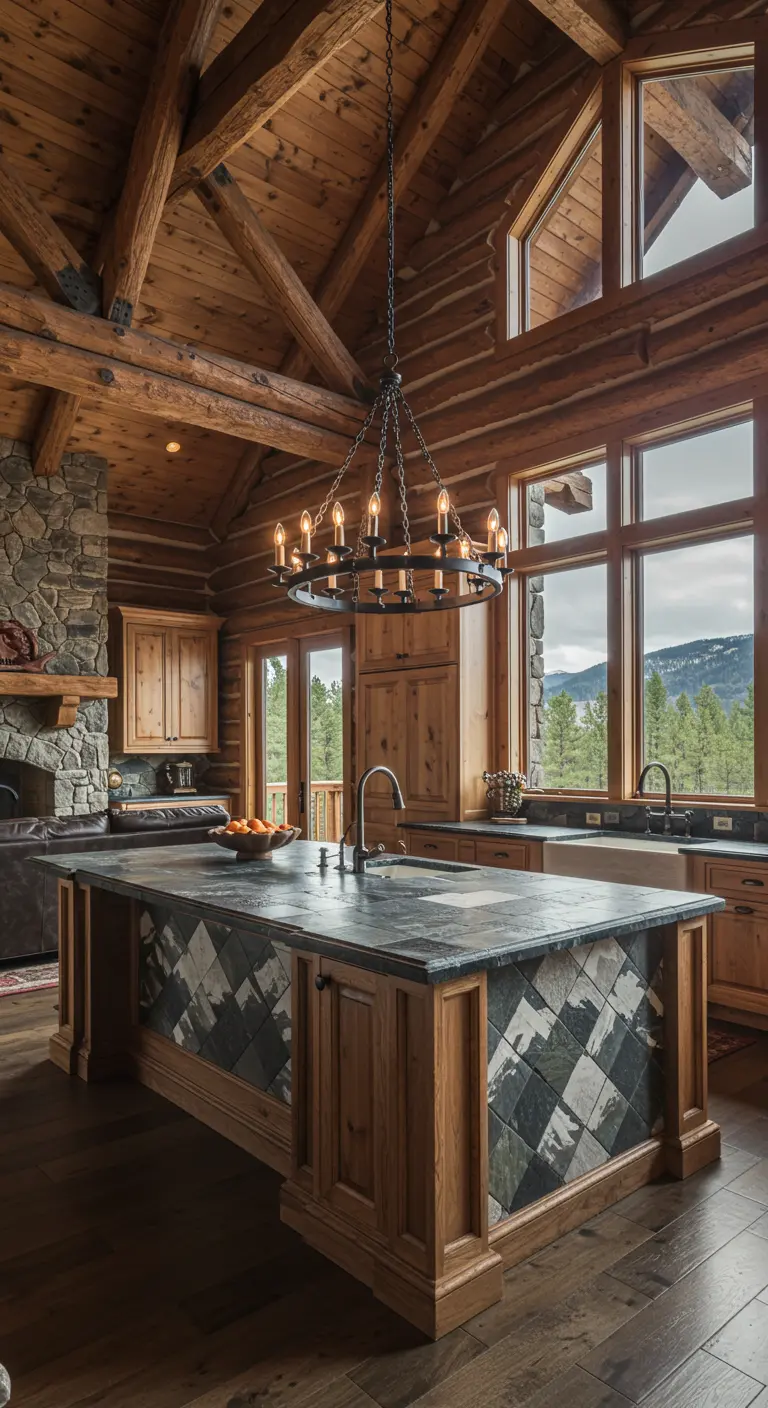
In a space defined by massive, raw materials like a log-cabin structure and a stone fireplace, your island needs to hold its own.
Here, rugged slate tiles laid in a diagonal pattern provide texture and heft, complementing the organic, powerful architecture of the home.
The dark tone of the slate grounds the island, while the simple wood cabinet base echoes the walls and ceiling.
This is a perfect example of design that honors its surroundings, ideal for a rustic mountain lodge.
13. Inject Softness with a Pastel Palette
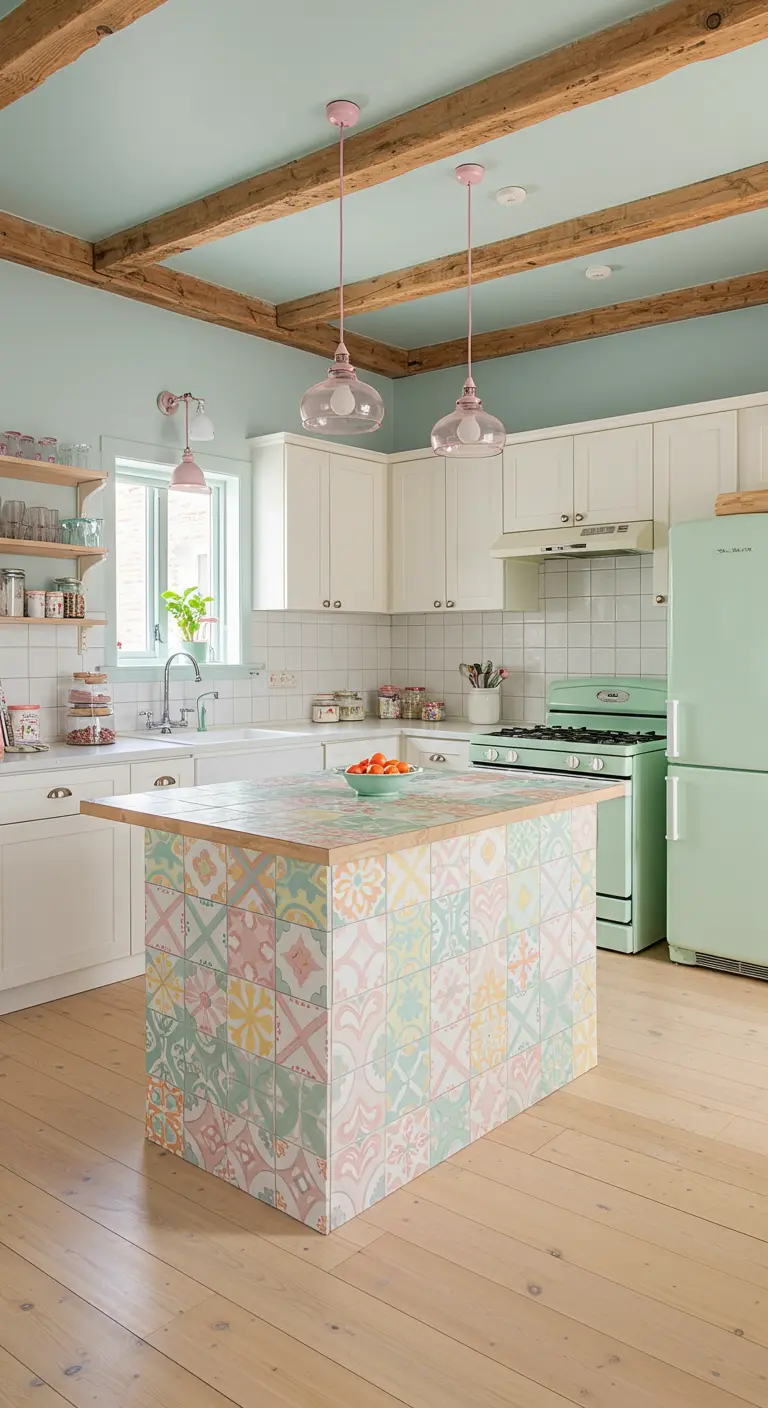
A rustic kitchen doesn’t have to be dark and heavy. A pastel palette can create a soft, cheerful, and whimsical atmosphere.
The patchwork of mint, pink, and yellow tiles on this island feels playful and sweet, especially when paired with a retro-style mint green refrigerator.
The light wood flooring and natural ceiling beams provide the rustic warmth, while the pale blue ceiling adds another layer of gentle color.
The pink glass pendants are a charming final touch, perfect for a dreamy, pastel-hued home.
14. Use a Runner to Guide the Eye

In a long, narrow galley kitchen, a runner rug is more than just a decorative element—it’s a crucial tool for guiding the eye and creating a sense of flow.
This beautiful vintage runner draws you through the space, connecting the different zones and adding color and warmth to the floor.
It balances the hard surfaces of the tile and cabinetry, making the narrow layout feel more intentional and welcoming.
This is a fantastic strategy for making small apartments feel more expansive.
15. Create a Focal Point with a Copper Hood
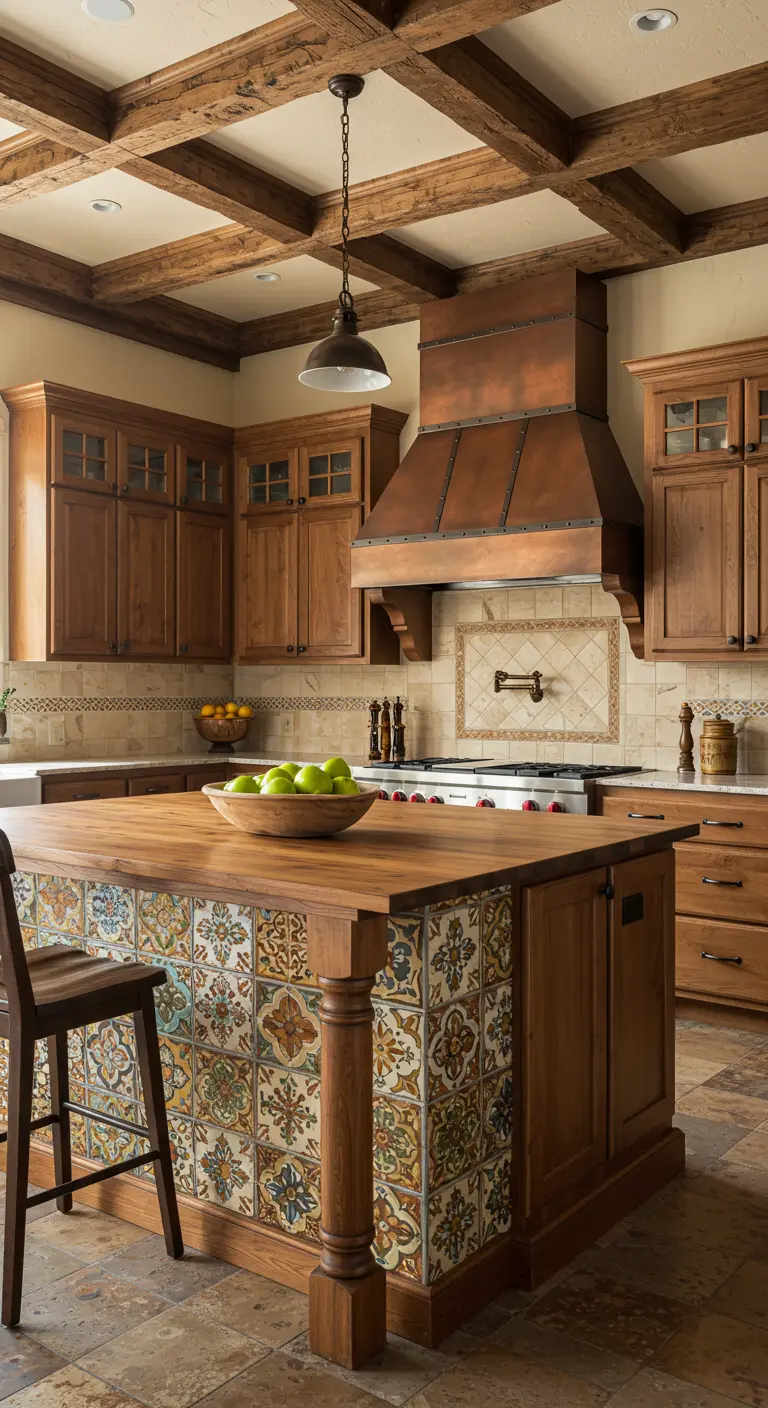
A custom range hood can be a stunning architectural feature that defines the entire kitchen.
This hammered copper hood introduces a warm, metallic element that instantly draws the eye and anchors the cooking zone.
It pairs beautifully with the warm wood cabinetry and the rustic, multi-colored patchwork tiles on the island, creating a cohesive and richly textured space.
This approach transforms a functional appliance into the centerpiece of your Mediterranean-inspired kitchen.
16. Explore Texture with Embossed Tile
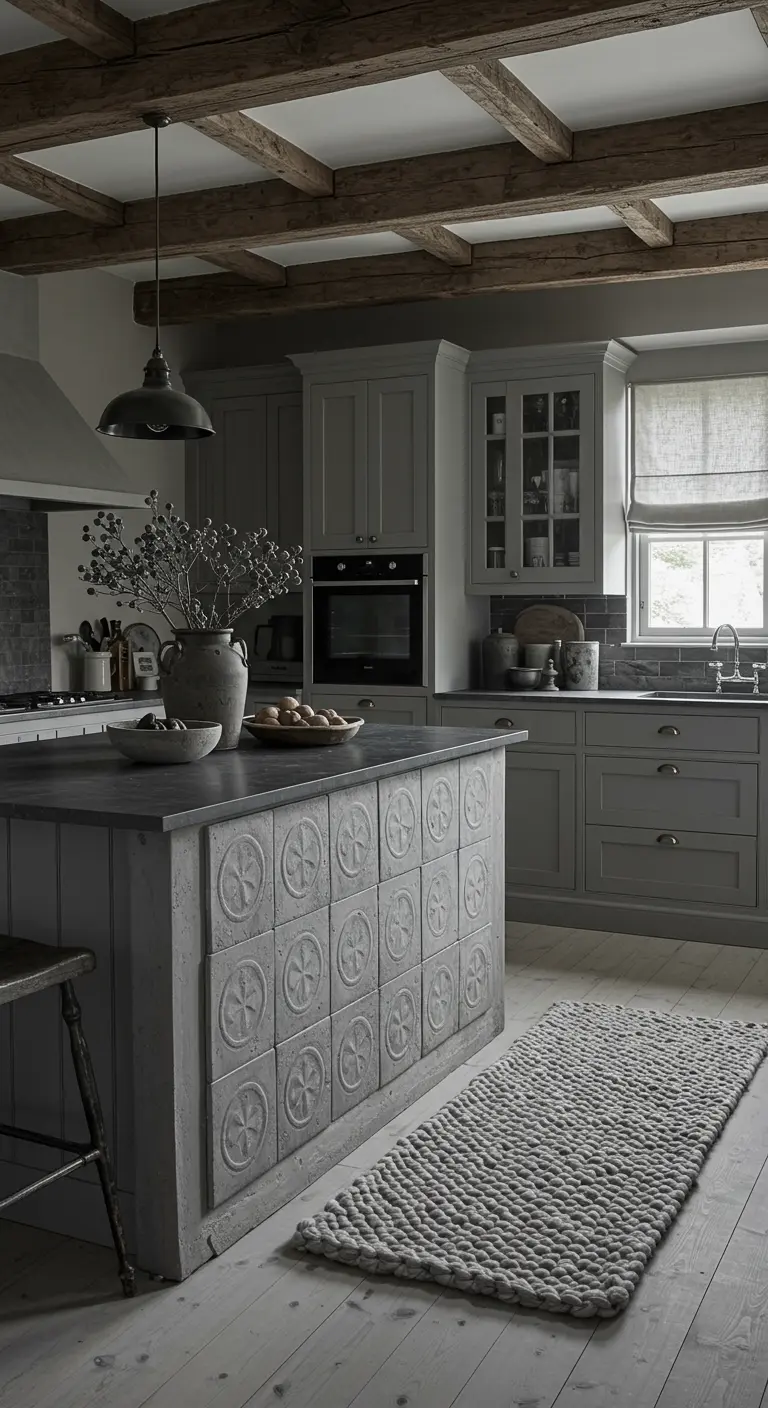
Pattern doesn’t always have to come from color. Consider using embossed or three-dimensional tiles for a subtle, textural effect.
This island is clad in gray concrete tiles with a raised circular pattern, adding depth and shadow play without introducing a new color to the serene, monochromatic scheme.
This is a sophisticated way to add interest to a minimalist space.
Paired with a chunky knit rug, it creates a tactile experience that is central to hygge-inspired design.
17. Let Your Style Run Wild
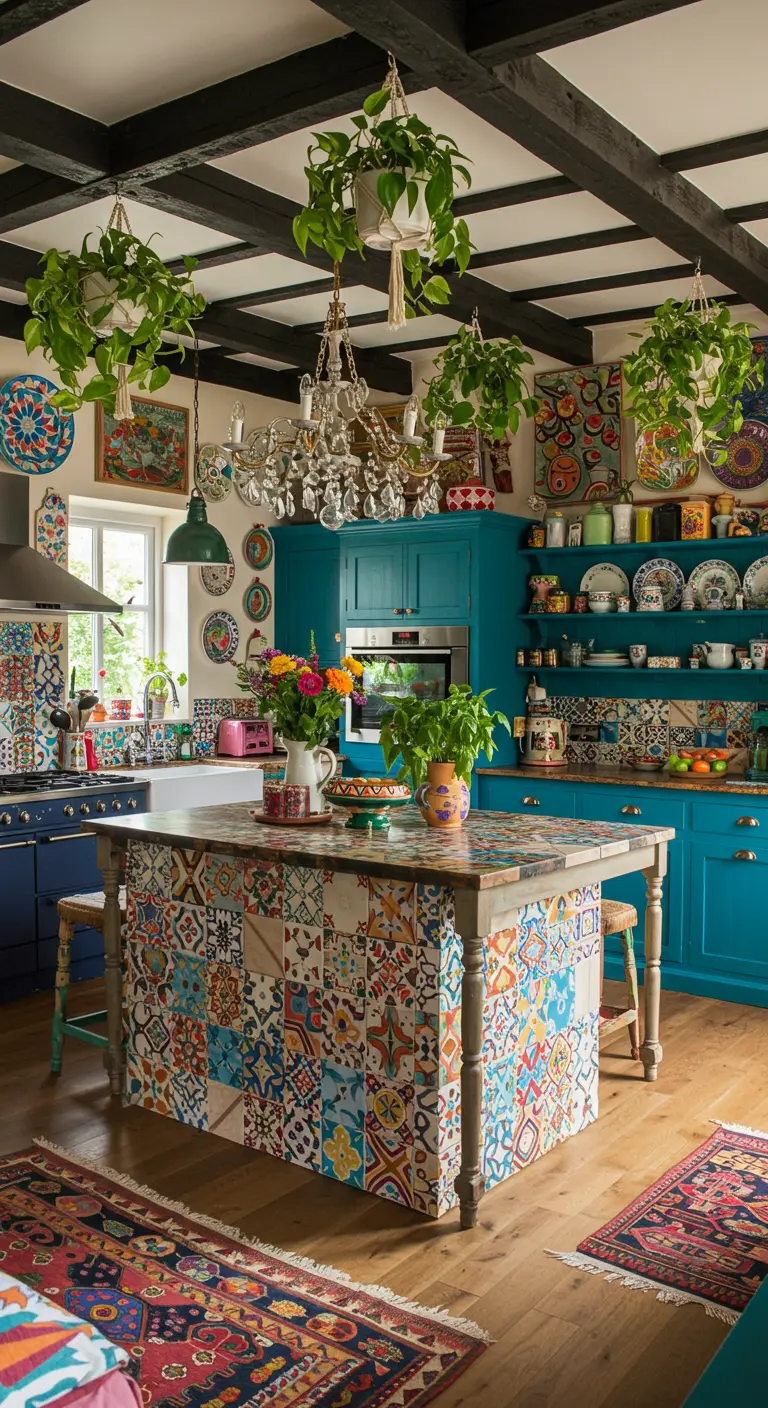
For the true maximalist, the kitchen is a canvas for joyful self-expression.
Here, a riot of colorful patchwork tile on the island and backsplash is paired with vibrant teal cabinets and walls adorned with art.
The key to making this work is repetition—the colors in the tiles are echoed in the plates, artwork, and flowers, creating a sense of intentional, happy chaos.
Lush hanging plants and a crystal chandelier add to the wonderfully eclectic, bohemian vibe.
18. Balance Pattern with Functional Elegance
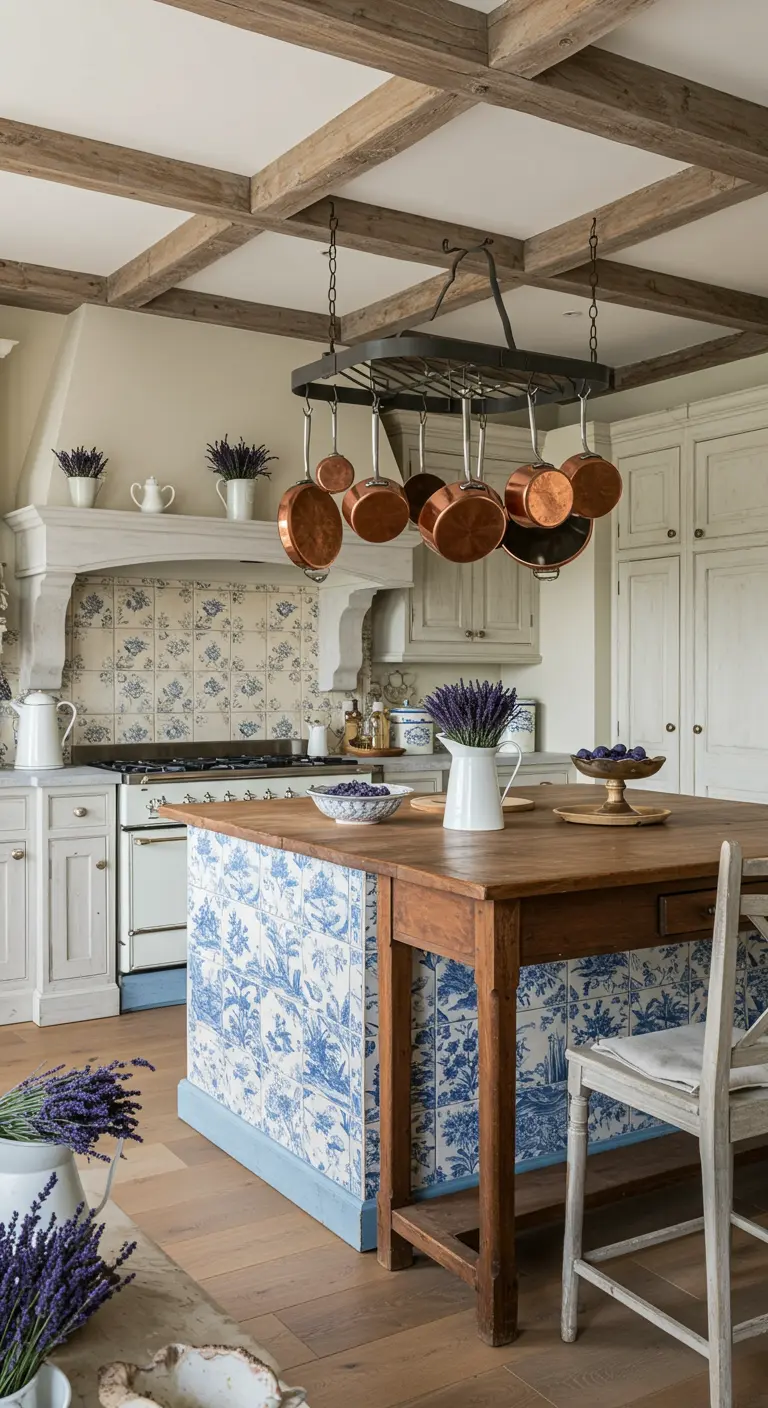
A classic blue-and-white toile or floral tile brings a touch of French country charm to any kitchen.
Balance the intricate pattern by incorporating practical, rustic elements like a ceiling-mounted pot rack with copper cookware.
This pairing of decorative beauty and everyday function is the essence of a welcoming, lived-in kitchen.
Fresh lavender in simple white pitchers connects beautifully to the blue in the tile, an easy styling trick that brings the French country garden indoors.
19. Connect to the Outdoors with Color
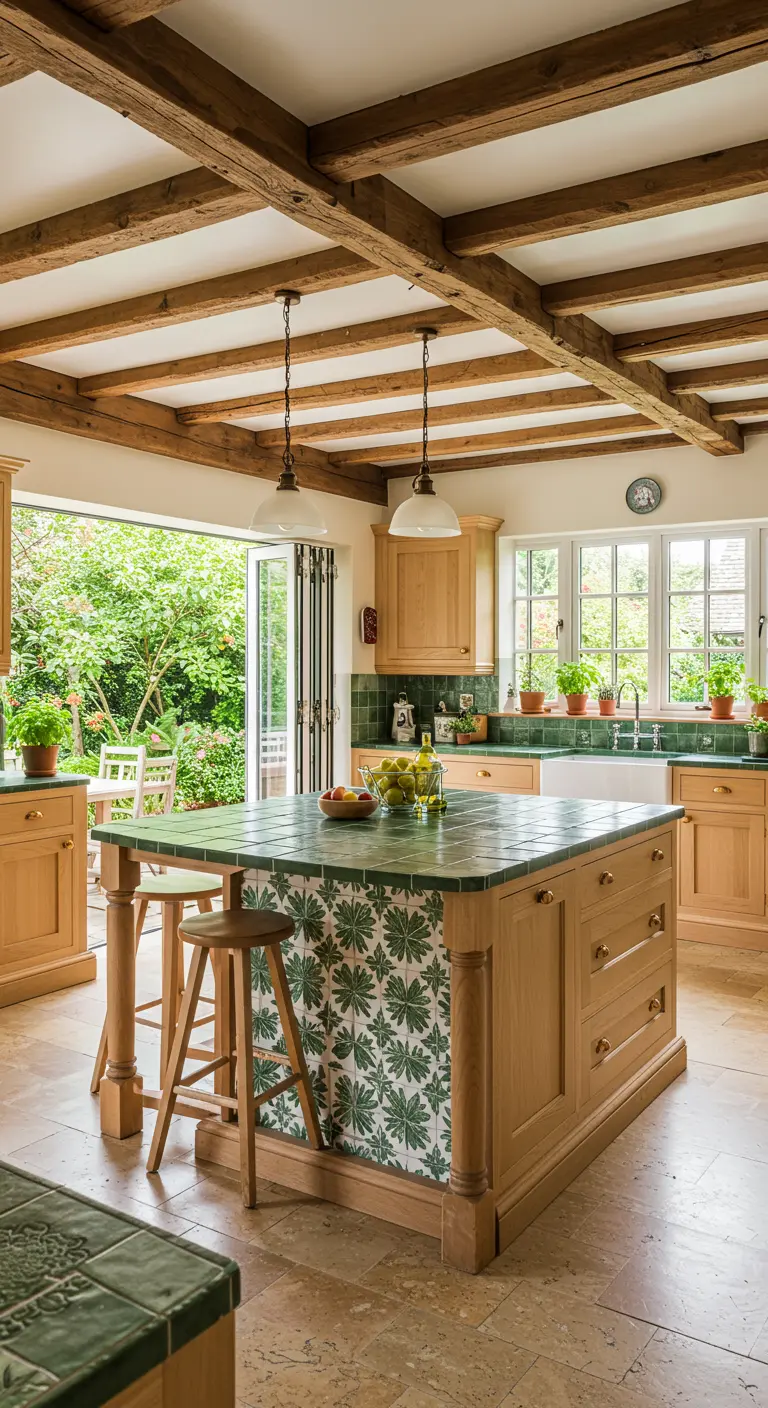
Create a seamless flow between your kitchen and garden by using a color palette inspired by nature.
The green leaf-patterned tile on this island directly reflects the lush greenery visible through the large folding glass doors.
This simple color connection makes the room feel larger and more integrated with its surroundings.
Natural oak cabinets and terracotta floor tiles further enhance the warm, earthy, nature-inspired feel.
20. Create a Tiled Medallion as a Centerpiece
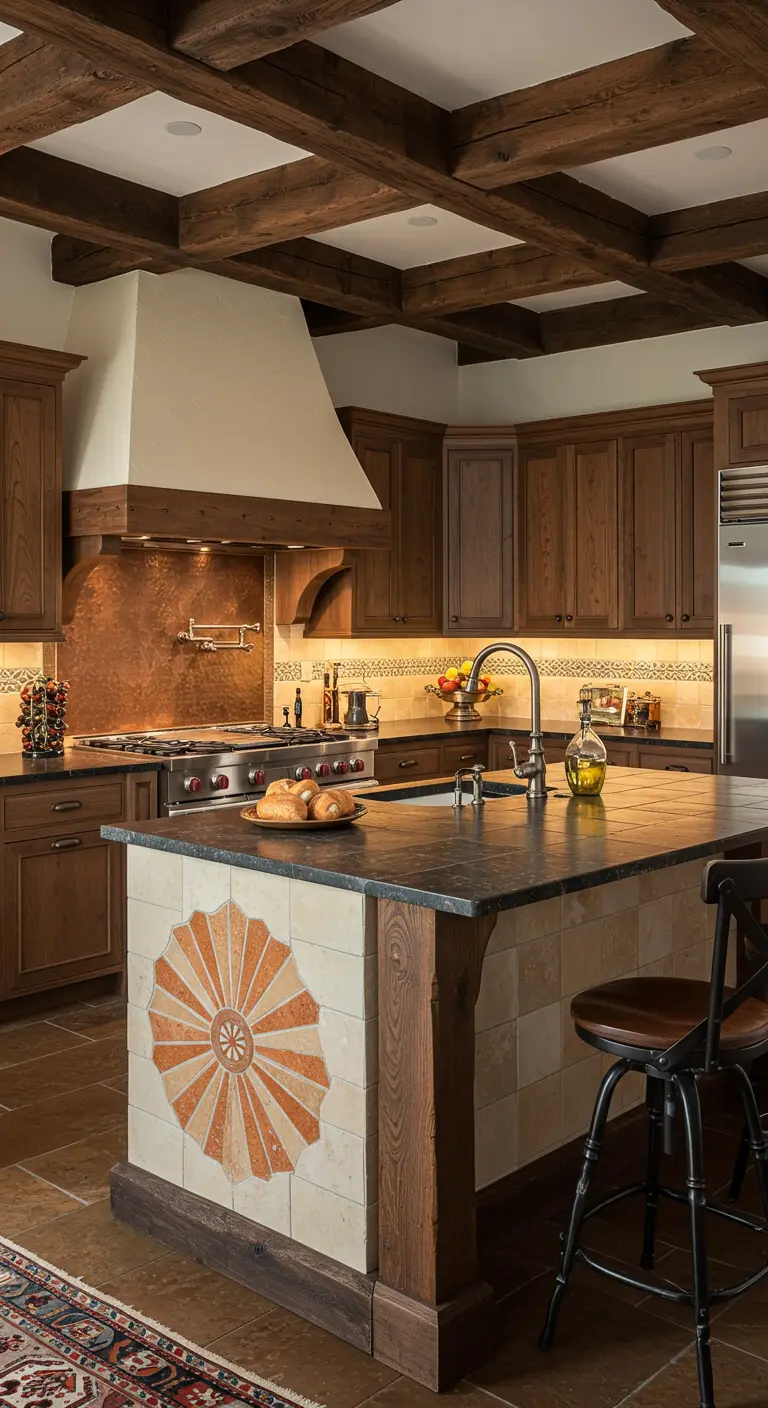
Instead of covering the entire island in a repeating pattern, consider creating a single, statement-making medallion.
This technique turns the island into a deliberate piece of art, drawing the eye to a central focal point.
Here, a sunburst-style medallion in warm terracotta tones is surrounded by neutral field tiles, allowing it to stand out.
This is a powerful way to add a custom, artisanal touch, reminiscent of historic Moroccan design.
21. Subtlety in a Modern Rustic Setting
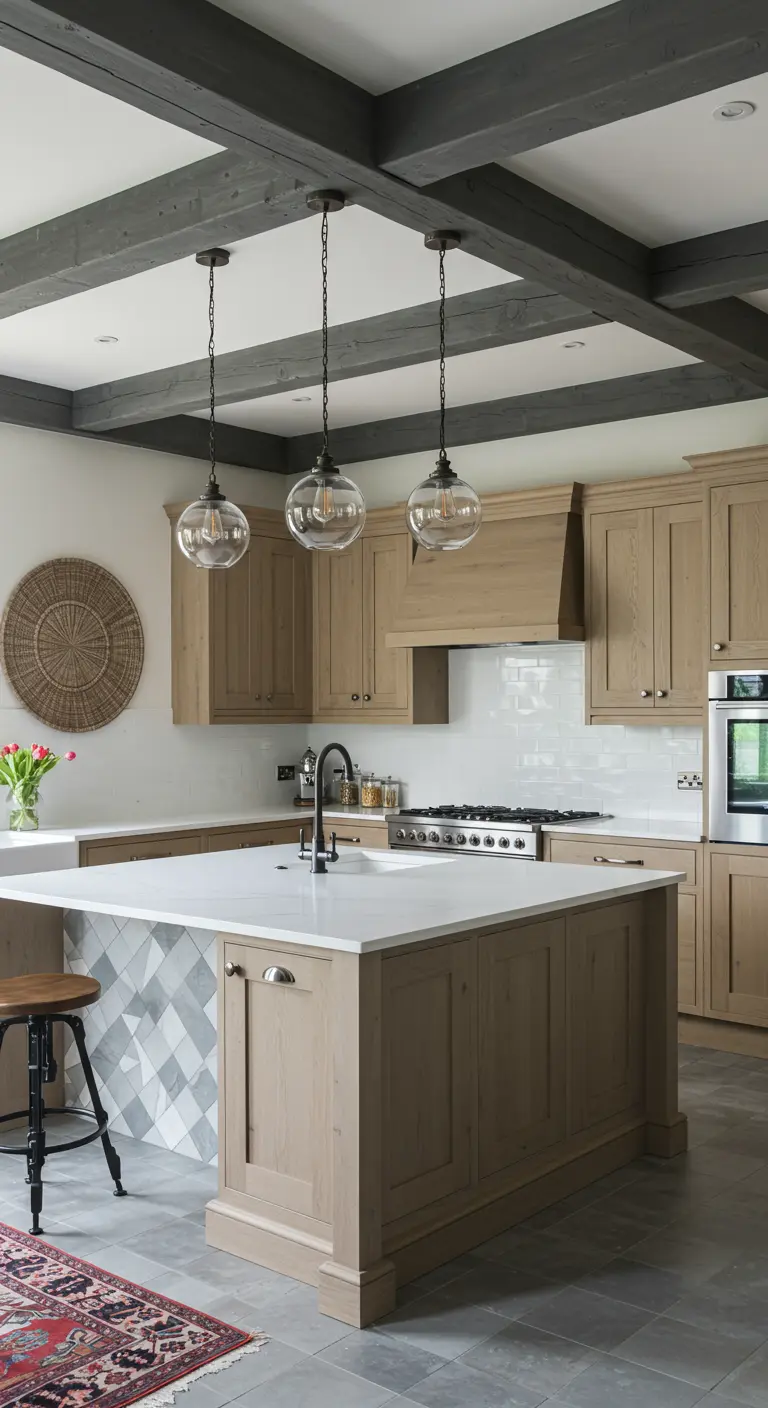
A patterned island can still feel subtle and modern. The key is a sophisticated, low-contrast color palette.
These geometric tiles use shades of gray, white, and taupe that blend beautifully with the light wood cabinetry and gray floor tiles.
The pattern adds visual interest without disrupting the calm, serene atmosphere.
This approach perfectly marries the clean lines of Scandinavian minimalism with rustic textures.
22. Achieve a Time-Worn, Antique Feel
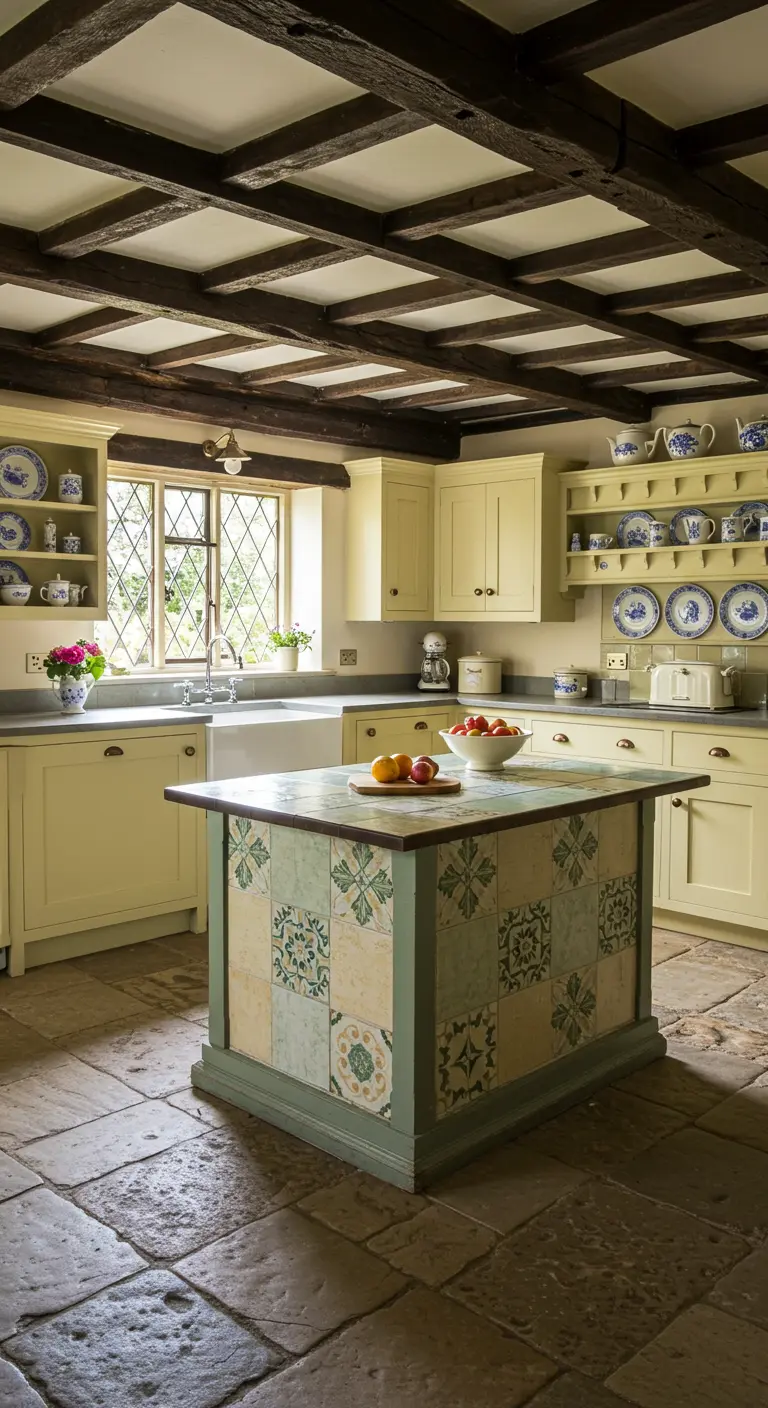
To create a kitchen that feels as if it has evolved over centuries, mix materials with a sense of history.
The patchwork of aged, faded tiles on this island looks collected over time, pairing beautifully with the rough-hewn stone flooring and buttery yellow cabinets.
Open plate racks displaying classic blue-and-white china enhance the sense of heritage and permanence.
This style celebrates imperfections, a core tenet of shabby chic design.
23. Lean into a Regional Style
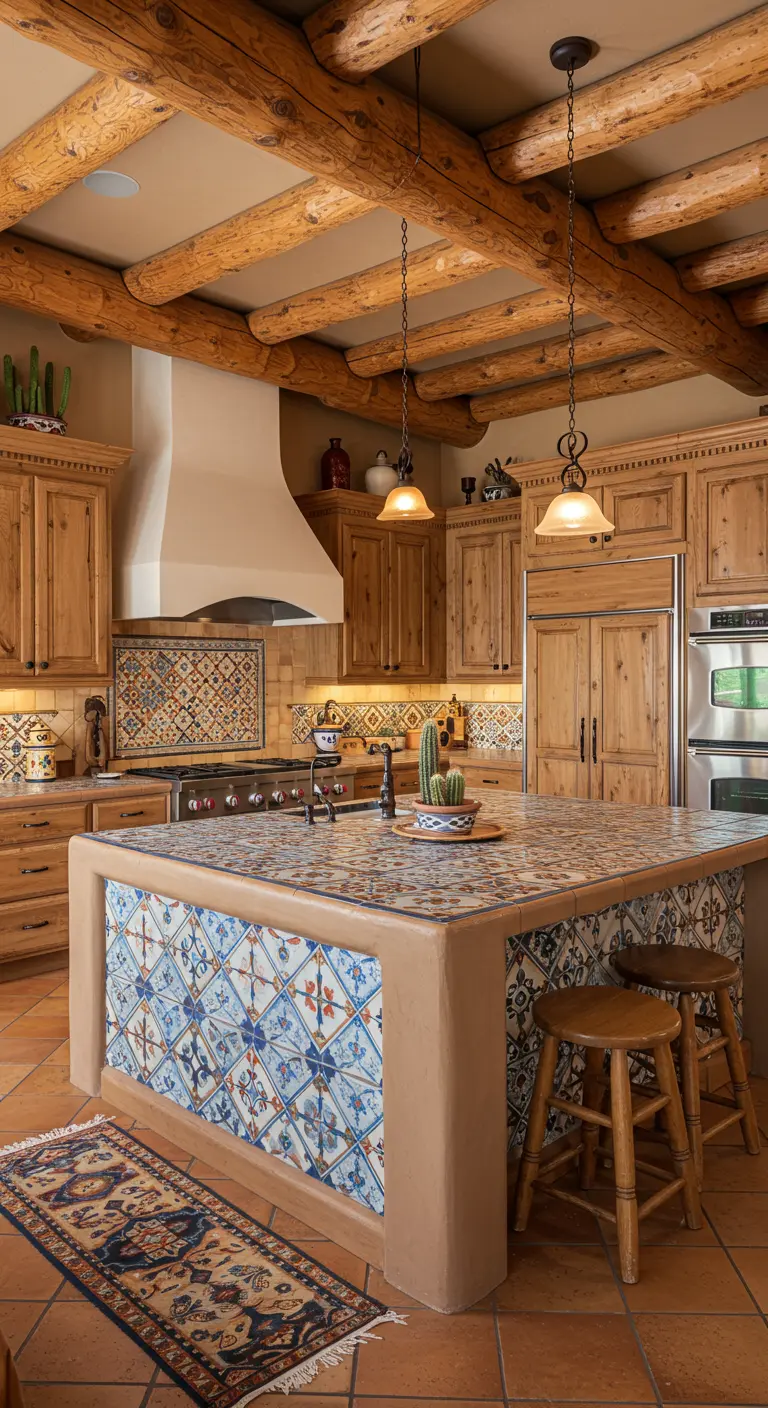
Embrace a specific regional aesthetic for a cohesive and transportive design. This kitchen is a beautiful example of Southwestern style.
The vibrant, hand-painted blue and terracotta tiles on the island and backsplash are hallmarks of the region, creating a bold and authentic look.
Rough-hewn log beams (vigas), knotty wood cabinets, and terracotta floor tiles complete the immersive, rustic atmosphere.
Even the decor, like the small cactus on the island, reinforces the desert aesthetic.
24. Use Pattern to Ground a Vaulted Space
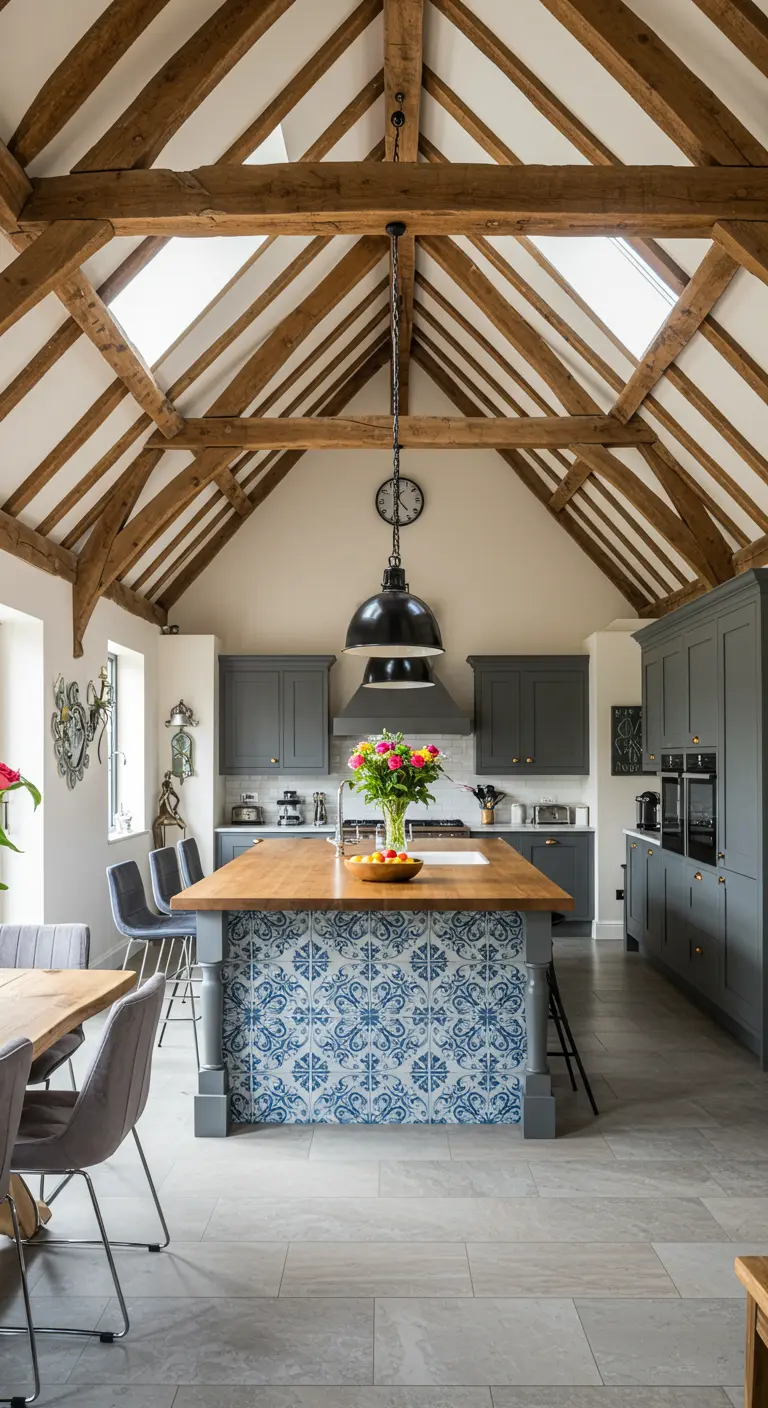
In a kitchen with soaring vaulted ceilings, a patterned island provides a crucial grounding element.
The bold blue-and-white tile helps to anchor the space visually, preventing the eye from only being drawn upwards to the dramatic wooden beams.
It creates a human-scale focal point in a grand room. The dark gray shaker cabinets offer a modern contrast to the rustic architecture.
The oversized industrial pendant light is scaled perfectly for the room’s impressive volume, a key principle in decorating lofty spaces.
25. Integrate Seating with a Tiled Banquette
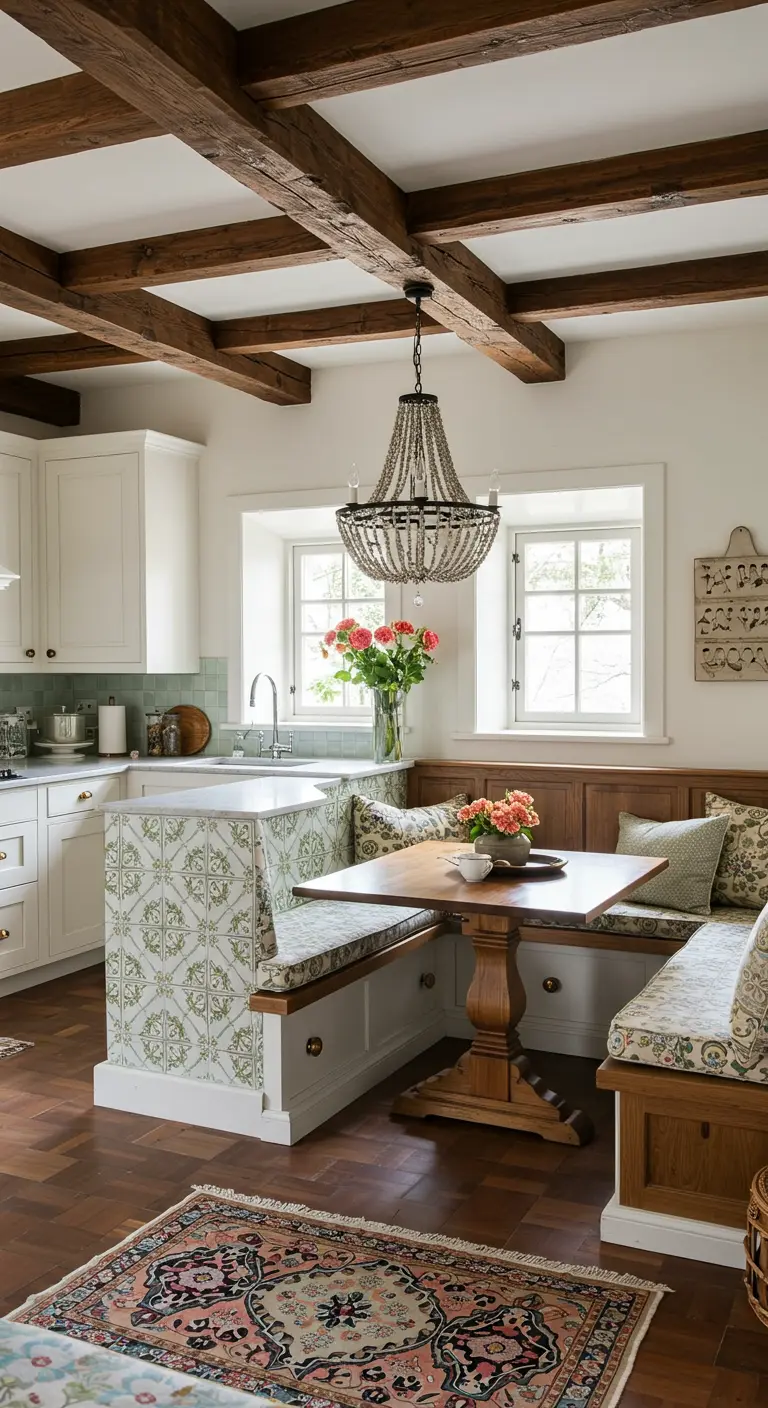
For the ultimate space-saving and custom solution, integrate your island with a built-in dining banquette.
Cladding the entire structure in the same tile creates a seamless, unified look that is both beautiful and highly functional.
This is an incredibly smart layout for smaller eat-in kitchens, as it provides ample seating without the clutter of separate chairs.
The result is a cozy, cafe-like corner that feels like a natural nook for gathering.
26. Choose a Theme and Commit to It

A strong, clear theme can turn a simple kitchen into a joyful, transportive space. This kitchen beautifully captures the essence of a sunny Italian lemon grove.
The lemon-patterned tile covering the island and backsplash is the undeniable star, instantly evoking a Mediterranean holiday.
White-washed walls and rustic ceiling beams provide a classic farmhouse backdrop, while yellow pottery and a hanging herb rack complete the story.
This immersive approach is a fun way to bring the spirit of a garden party indoors.
27. Create Mood with Dark, Textural Materials
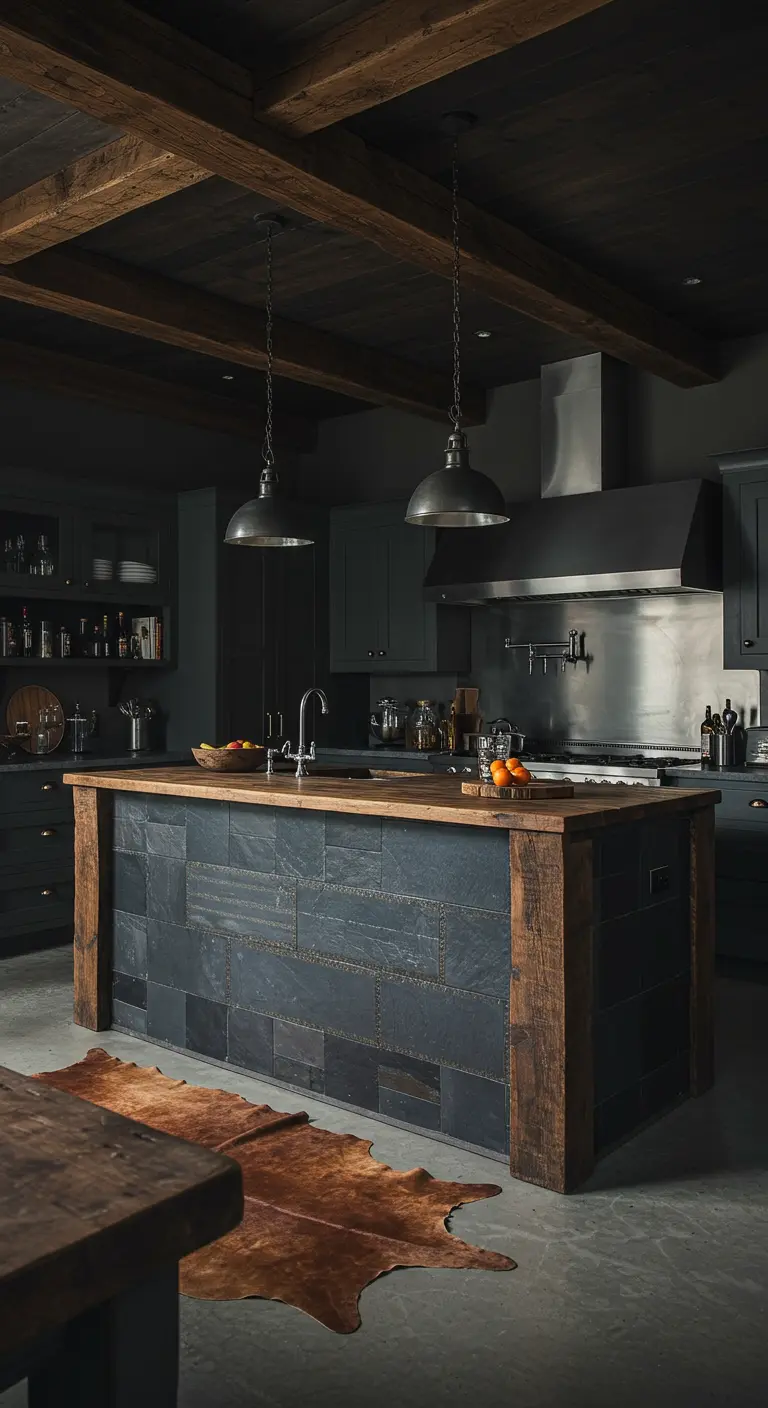
A kitchen can be a sophisticated, moody retreat. The key is to layer dark tones and rich textures.
This island combines rough-hewn dark wood with textured slate tiles, creating a monolithic, commanding presence.
Matte charcoal cabinets and a stainless steel backsplash recede into the background, allowing the island to be the focal point.
Industrial pendant lights and a cowhide rug add to the dark, handsome aesthetic.
28. Honor Grand Architecture with Timeless Choices
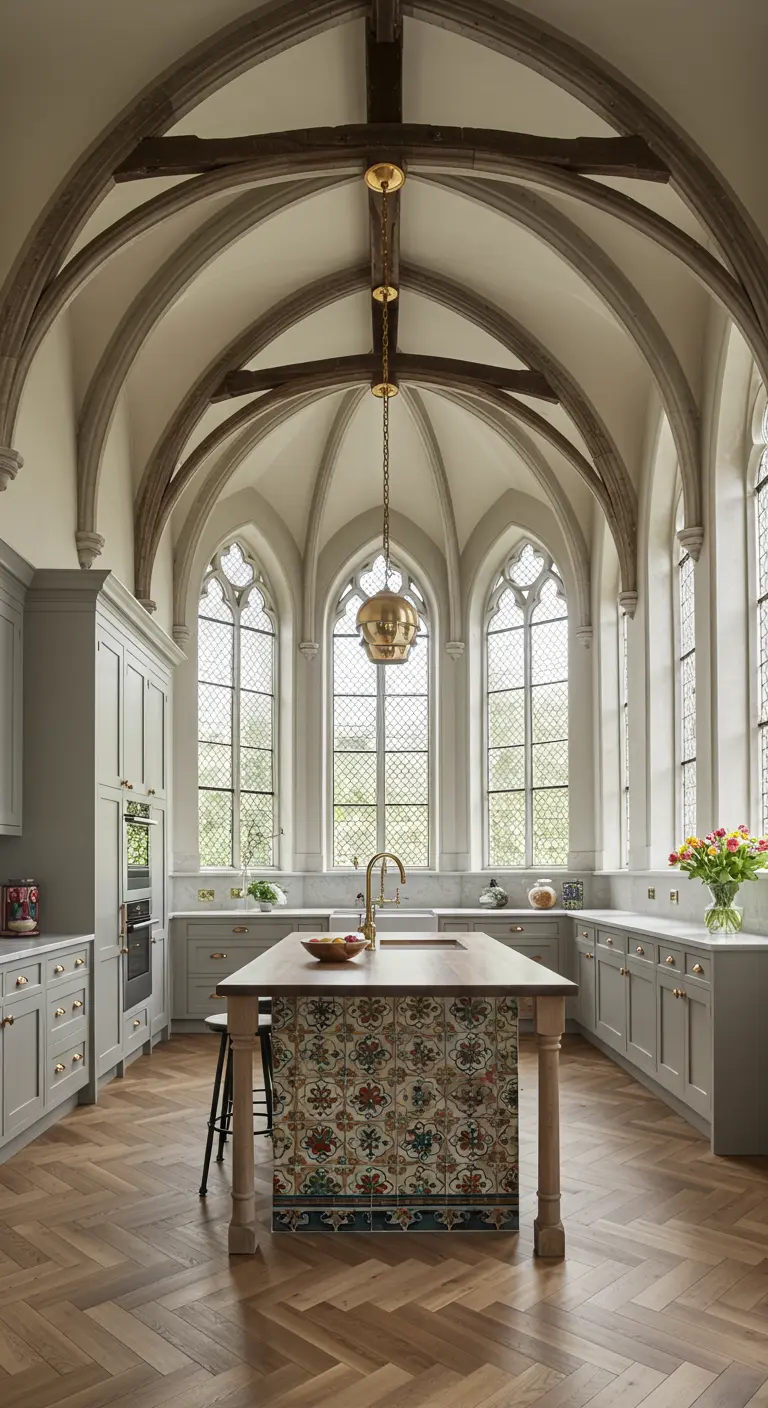
When your kitchen is set within a space of incredible architectural beauty, your design choices should honor it.
The gothic arches and vaulted ceilings are the stars here, so the kitchen design is elegant and restrained.
A simple patterned tile in muted, earthy tones adds interest to the island without competing with the grandeur of the room.
The herringbone wood floor provides a classic foundation, a choice often seen in historic Parisian apartments.
29. Frame Tile Like Artwork
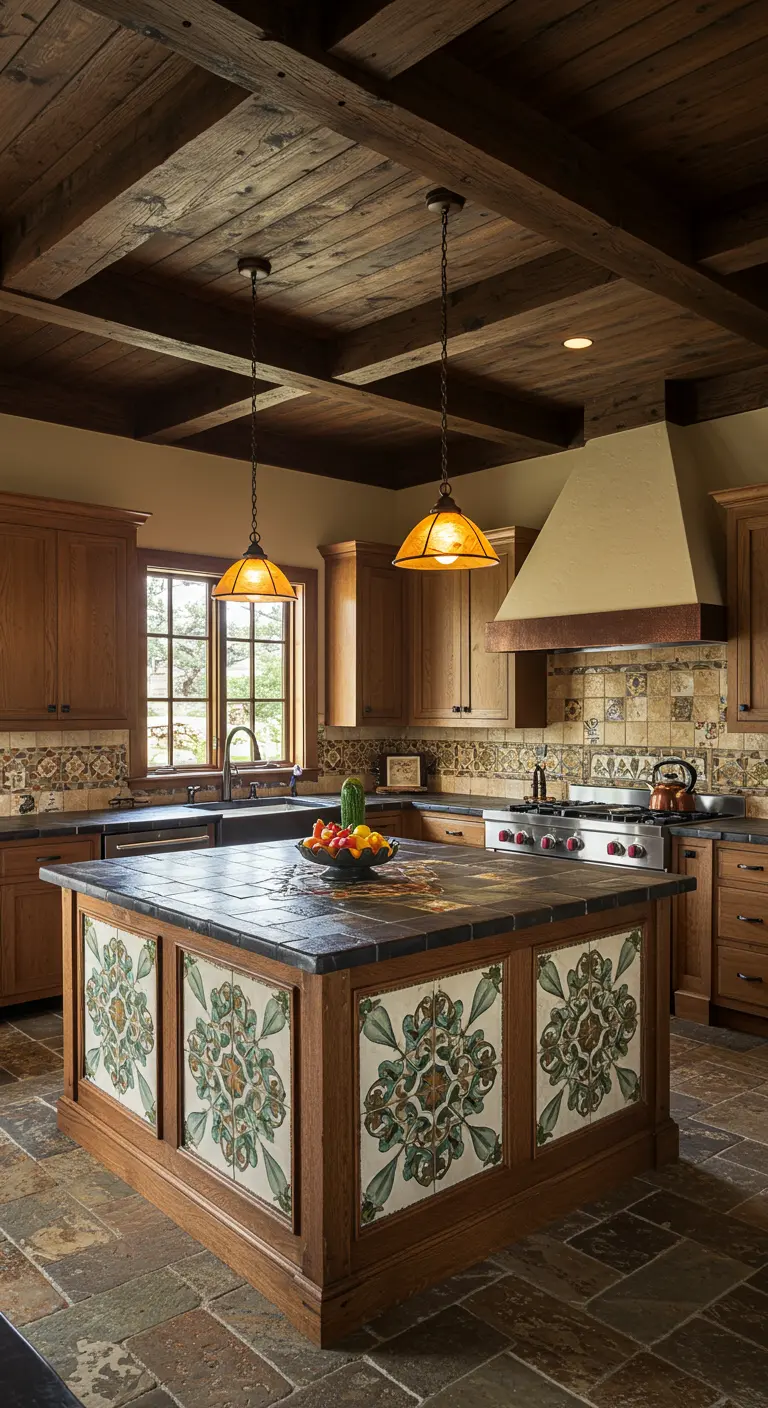
Instead of tiling an entire surface, consider using wood molding to frame sections of patterned tile, treating them like individual pieces of art.
This technique breaks up the surface of a large island, adding rhythm and detail. It feels more like custom furniture than simple cabinetry.
The warm wood tones of the frames and cabinets harmonize with the earthy greens and creams in the tile, creating a cohesive, artisanal look.
This is a hallmark of the modern rustic style—blending craftsmanship with natural materials.
30. Mix Materials for an Eclectic Rustic Look
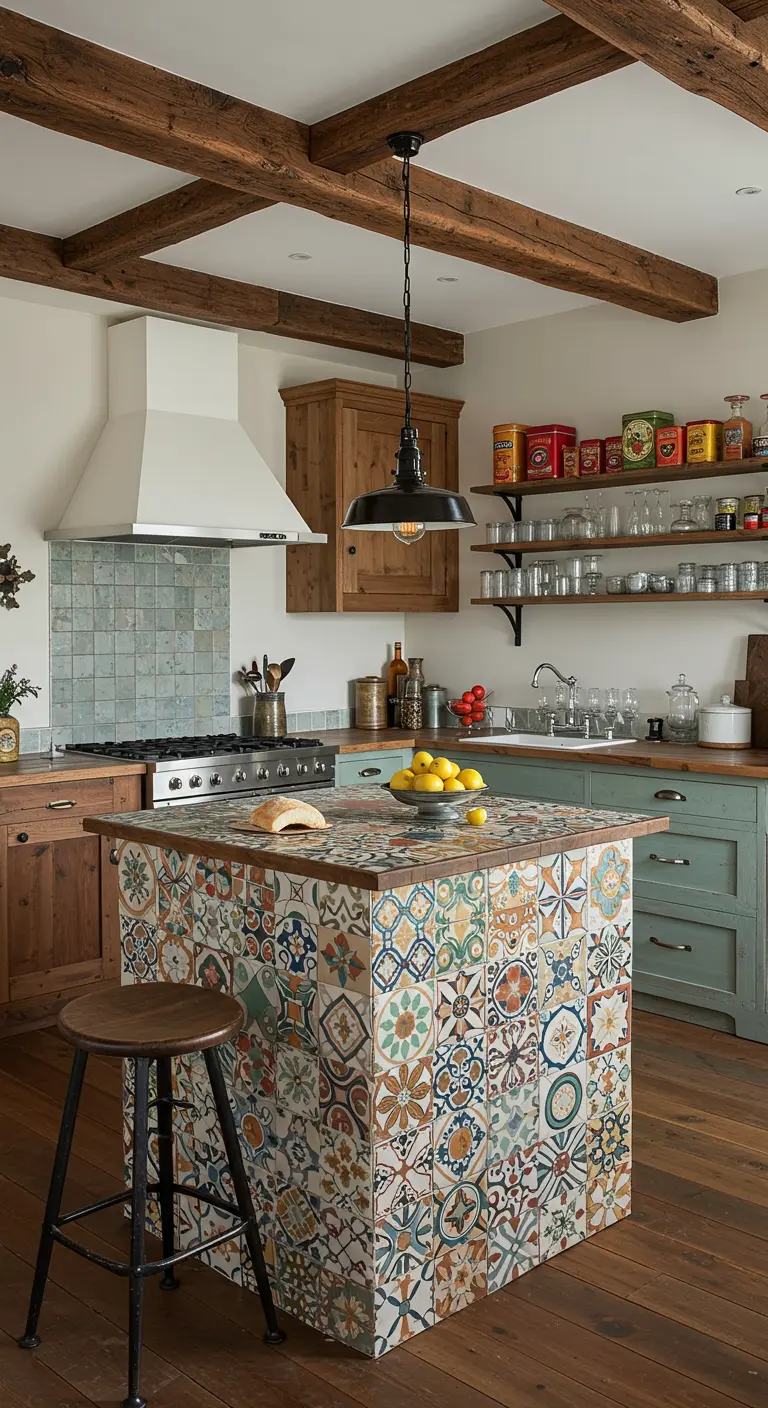
A truly rustic kitchen feels assembled over time, confidently mixing different materials, colors, and patterns.
Here, a bold patchwork of colorful tiles on the island provides a vibrant focal point against dusty green cabinets and weathered wood floors.
Open shelving filled with mismatched glassware and vintage tins adds to the personal, collected feel.
This is the essence of a textured bohemian kitchen: rich with stories and personality.
31. Achieve Serenity with Sculptural Forms
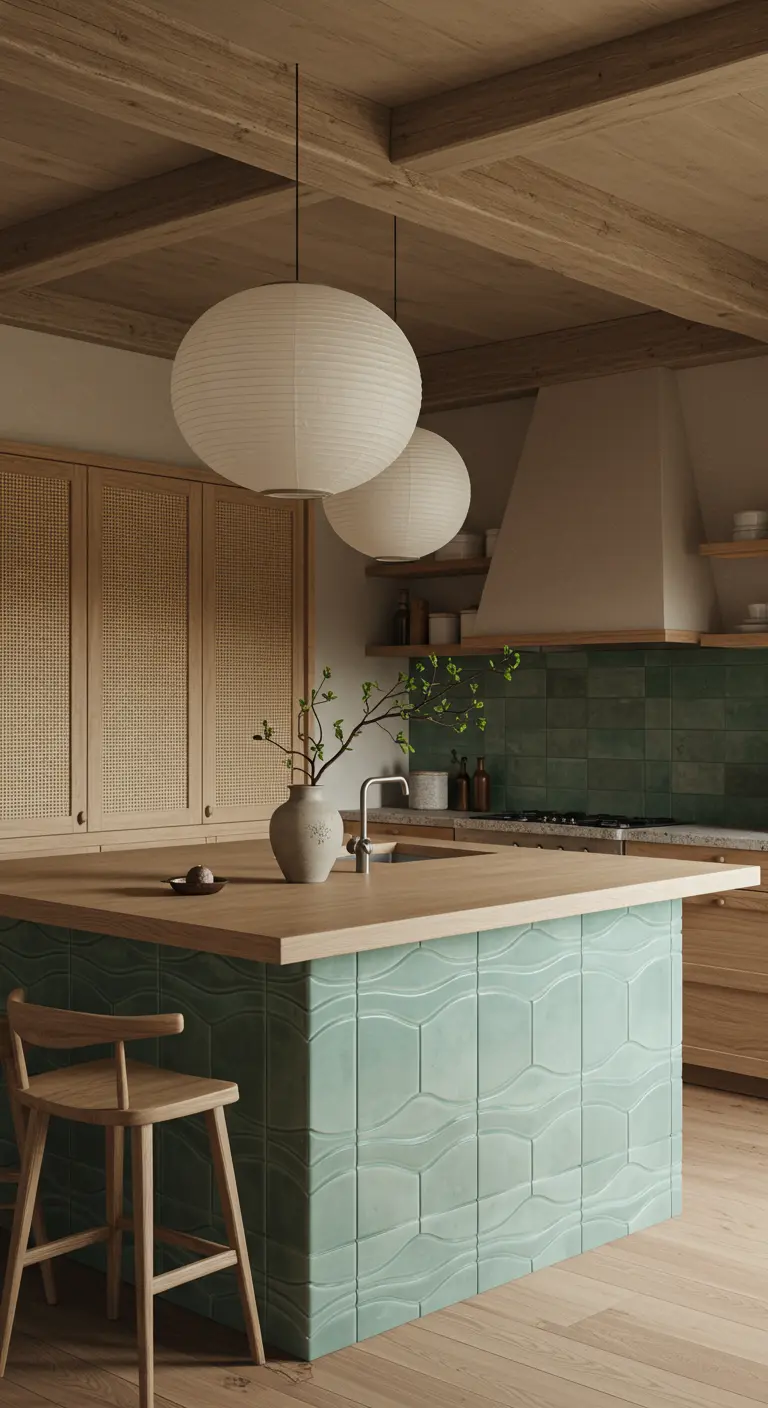
For a calm, minimalist take on the rustic kitchen, focus on clean lines, natural materials, and sculptural forms.
The island is clad in wavy, three-dimensional tiles in a soft seafoam green, creating a sense of gentle movement.
This pairs beautifully with the simple butcher block countertop and light wood cabinets with rattan fronts.
Large paper lantern pendants provide soft, diffused light, completing the serene, Japandi-inspired aesthetic.
